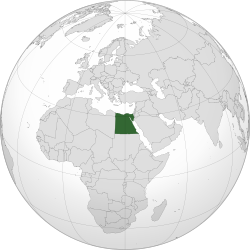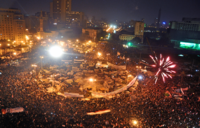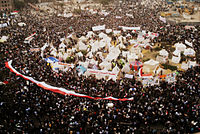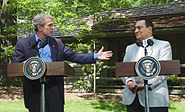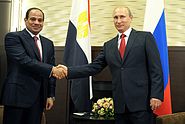Kullanıcı:Sp1dey/Çalışma
Mısır | |||||||||||||
|---|---|---|---|---|---|---|---|---|---|---|---|---|---|
Yerküre üzerindeki konumu | |||||||||||||
| Başkent ve en büyük şehir | Kahire 30°2′K 31°13′D / 30.033°K 31.217°D | ||||||||||||
| Resmî dil(ler) | Arapça | ||||||||||||
| Ulusal dil | Mısır Arapçası[a] | ||||||||||||
| Resmî din | bkz. Mısır'da din[b] | ||||||||||||
| Demonim | Mısırlı (Arap) | ||||||||||||
| Hükûmet | Otoriter rejim altında yarı başkanlık sistemli üniter cumhuriyet[5][6][7][8][9] | ||||||||||||
| |||||||||||||
| Yasama organı | Parlamento | ||||||||||||
| Senato | |||||||||||||
| Temsilciler Meclisi | |||||||||||||
| Tarihçe | |||||||||||||
| |||||||||||||
| Yüzölçümü | |||||||||||||
• Toplam | 1.010.408[13][14] km2 (29.) | ||||||||||||
• Su (%) | 0,632 | ||||||||||||
| Nüfus | |||||||||||||
• 2023[15] tahminî | |||||||||||||
• 2017 sayımı | |||||||||||||
• Yoğunluk | 103,56/km2 (118..) | ||||||||||||
| GSYİH (SAGP) | 2021 tahminî | ||||||||||||
• Toplam | |||||||||||||
• Kişi başına | |||||||||||||
| GSYİH (nominal) | 2023 tahminî | ||||||||||||
• Toplam | |||||||||||||
• Kişi başına | |||||||||||||
| Gini (2019) | ▼ 31.9[17][18] orta · 46. | ||||||||||||
| İGE (2021) | yüksek · 97. | ||||||||||||
| Para birimi | Mısır lirası (EGP) | ||||||||||||
| Zaman dilimi | UTC+2 (DAS) | ||||||||||||
• Yaz (YSU) | UTC+3 (DAYS) | ||||||||||||
| Trafik akışı | sağ | ||||||||||||
| Telefon kodu | 20 | ||||||||||||
| İnternet alan adı | .eg | ||||||||||||
Mısır (Arapça: مصر, romanize: Mısr), resmî olarak Mısır Arap Cumhuriyeti, Afrika'nın kuzeydoğu köşesi ile Asya'nın güneybatı köşesinde Sina Yarımadası'nı kapsayan kıtalararası bir ülkedir. Kuzeyinde Akdeniz, kuzeydoğusunda Filistin'in Gazze Şeridi ve İsrail, doğusunda Kızıldeniz, güneyinde Sudan ve batısında Libya ile komşudur. Kuzeydoğudaki Akabe Körfezi, Mısır'ı Ürdün ve Suudi Arabistan'dan ayırmaktadır. Kahire, Mısır'ın başkenti ve en büyük şehridir. İkinci büyük şehri olan İskenderiye ise Akdeniz kıyısında önemli bir sanayi ve turizm merkezidir. Yaklaşık 100 milyon nüfusuyla Mısır, dünyanın en kalabalık 14'üncü, Afrika'nın ise en kalabalık üçüncü ülkesidir.
Nil Deltası boyunca uzanan Mısır, MÖ 6 ile 4 bininci yıllara kadar dayanan mirası ile en uzun tarihî geçmişe sahip ülkelerden biridir. Medeniyetin beşiği olarak kabul edilen Antik Mısır; yazı, tarım, kentleşme, organize din ve merkezî hükûmet alanlarındaki ilk gelişmelerden bazılarına sahne olmuştur.[20] Yedinci yüzyılda büyük ölçüde İslam'ı benimsemeden önce Mısır Hristiyanlığın önemli merkezlerinden biriydi. Kahire, 10. yüzyılda Fâtımîler'in, 13. yüzyılda ise Memlûk Devleti'ne başkentlik yapmıştır. Mısır daha sonra, 1517 yılında Osmanlı İmparatorluğu'nun bir parçası oldu ve Kavalalı Mehmed Ali Paşa'nın 1867'de özerk bir Hidivlik kurmasına kadar Osmanlı hâkimiyeti altında kaldı. Ülke daha sonra Britanya İmparatorluğu tarafından işgal edildi ve 1922'de monarşi olarak bağımsızlığını kazandı. 1952 devriminin ardından Mısır'da cumhuriyet ilan edildi ve 1958'de ülke Suriye ile birleşerek Birleşik Arap Cumhuriyeti kuruldu. Bu cumhuriyet 1961'de dağılmıştır. Mısır 1948, 1956, 1967 ve 1973'te İsrail'le birçok silahlı çatışmaya girmiş ve 1967'ye kadar Gazze Şeridi'ni işgal etmiştir. 1978'de Mısır, Sina'dan çekilmesi karşılığında Camp David Sözleşmesi'ni imzalayarak İsrail'i resmî olarak tanımış oldu. 2011 Mısır Devrimi'ne ve Hüsnü Mübarek'in devrilmesine neden olan Arap Baharı'nın ardından ülke uzun süren bir siyasi istikrarsızlık dönemiyle karşı karşıya kaldı. Buna 2012'de Muhammed Mursi'nin öncülük ettiği Müslüman Kardeşler bağlantılı kısa ömürlü İslamcı hükûmetin seçilmesi ve bu hükûmetin 2013'teki kitlesel protestoların ardından devrilmesi de dahil idi.
2014 yılında seçilen ve o zamandan beri Abdülfettah es-Sisi tarafından yönetilen Mısır'ın yarı başkanlık sistemine dayalı mevcut hükûmeti, bazı gözlemci kurumlar tarafından otoriter olarak değerlendirilirken ülkenin insan hakları durumunun zayıf kalmasından sorumlu tutulmaktadır. Mısır'ın resmî dini İslam, resmî dili ise Arapça'dır.[21] Nüfusun büyük bir çoğunluğu, ekilebilir tek arazinin bulunduğu, yaklaşık 40.000 kilometrekarelik Nil Nehri kıyılarına yakın alanlarda yaşamaktadır. Mısır topraklarının çoğunu Sahra Çölü oluşturur ve buradaki geniş alanlarda seyrek yerleşimler gözlemlenir. Mısır'da yaşayanların yaklaşık %43'ü ülkenin kentsel alanlarında yaşamaktadır.[22] Bunların çoğu Kahire, İskenderiye ve Nil Deltası'ndaki diğer büyük şehirlerin yoğun nüfuslu merkezlerine yayılmış durumdadır.
Mısır Kuzey Afrika, Orta Doğu ve İslam dünyasında bölgesel bir güç, dünya çapında ise orta bir güç olarak değerlendirilmektedir.[23] Afrika'nın üçüncü büyük ekonomisi, dünyanın nominal GSYİH açısından 38. ve kişi başına nominal GSYİH açısından 127. en büyük ekonomisi olan, çeşitlendirilmiş bir ekonomiye sahip, gelişmekte olan bir ülkedir.[24] Mısır; Birleşmiş Milletler, Bağlantısızlar Hareketi, Arap Birliği, Afrika Birliği, İslam İşbirliği Teşkilatı, Dünya Gençlik Forumu'nun kurucu üyesi olmakla beraber ve bir BRICS üyesidir.
Etimoloji[değiştir | kaynağı değiştir]
| |
| |
Tarihçe[değiştir | kaynağı değiştir]
Tarih öncesi dönem ve Antik Mısır[değiştir | kaynağı değiştir]
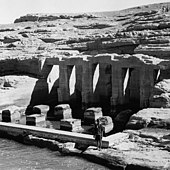
Nil kıyıları boyunca ve çöl vahalarında kaya oymalarına dair kanıtlar bulunmaktadır. MÖ 10. binyılda avcı-toplayıcı ve balıkçı kültürünün yerini tahıl öğütme kültürü almıştır. MÖ 8000 civarında iklim değişiklikleri veya aşırı otlatma, Mısır'ın pastoral topraklarını kurutarak Sahra'yı oluşturmaya başladı. İlk kabile halkları, yerleşik bir tarım ekonomisi ve daha merkezi bir toplum geliştirdikleri Nil Nehri civarlarına doğru göç etmiştir.[38]
Milattan önce yaklaşık 6000'li yıllara gelindiğinde, Nil Vadisi'nde Neolitik bir kültür kök salmaya başladı.[39] Neolitik çağda, Yukarı ve Aşağı Mısır'da birbirinden bağımsız olarak birkaç hanedan öncesi kültür gelişti. Badâri kültürü ve onun devamı olan Nakada, genel olarak Mısır hanedanlığının öncüleri olarak kabul edilmektedir. Bilinen en eski Aşağı Mısır bölgesi olan Merimda, Badâri'den yaklaşık yedi yüz yıl öncesine dayanmaktadır. Çağdaş Aşağı Mısır toplulukları güneydeki benzerleriyle iki bin yıldan fazla bir süre bir arada yaşamış ve ticaret yoluyla sık sık etkileşim kurmuşlarsa da kültürel olarak birbirlerinden farklı kalmışlardır. Mısır hiyeroglif yazıtlarının bilinen en eski kanıtı hanedan öncesi dönemde, yaklaşık MÖ 3200'e tarihlenen Nakada III çömlek kaplarında görülmüştür.[40]
Kral Menes tarafından MÖ 3150 dolaylarında birleşik bir krallık kuruldu ve bu, sonraki üç bin yıl boyunca Mısır'ı yöneten bir dizi hanedanlığın ortaya çıkmasına zemin hazırladı. Mısır kültürü bu uzun dönemde gelişti ve dini, sanatı, dili ve gelenekleri bakımından Mısırlılara özgü olarak kaldı. Birleşik bir Mısır'ın ilk iki yönetici hanedanı, MÖ 2700-2200 dolaylarında birçok piramit inşa edilen Eski Krallık dönemine zemin hazırladı. Bu piramitlerden en önemlisi, Zoser'in Üçüncü Hanedan piramidi ve Dördüncü Hanedan'a ait Gize piramitleridir.
Birinci Ara Dönem, yaklaşık 150 yıl süren bir siyasi çalkantı dönemini başlattı.[41] Bununla birlikte, daha güçlü Nil taşkınları ve hükümetin istikrara kavuşması, Orta Krallık'taki ülkeye refahı geri getirdi. MÖ 2040'ta ise Firavun III. Amenemhat döneminde zirveye ulaşıldı. İkinci Ara Dönem, Mısır topraklarındaki ilk yabancı yöneticili bir hanedan olan Sami Hiksos'un gelişinin habercisiydi. Hiksos istilacıları, MÖ 1650 civarında Aşağı Mısır'ın çoğunu ele geçirdiler ve Avaris'te yeni bir başkent kurdular. İstilacılar Mısır'daki on sekizinci hanedanı kuran ve başkenti Memfis'ten Teb'e taşıyan I. Ahmose liderliğindeki Yukarı Mısır kuvvetleri tarafından kovuldular.
MÖ 1550-1070 dolaylarındaki Yeni Krallık, on sekizinci hanedan dönemi ile başladı ve Mısır'ın, Nübye'deki Tombos'a kadar güneydeki bir imparatorluğa kadar genişleyen ve doğuda Levant'ın bazı kısımlarını da kapsayan uluslararası bir güç olarak yükselişini temsil ediyordu. Bu dönem Hatşepsut, III. Thutmose, Akhenaton ve eşi Nefertiti, Tutankhamun ve II. Ramses gibi en tanınmış Firavunlardan bazılarını içermektedir. Monoteizm, bu dönemde "Atenizm" olarak ortaya çıktı. Ülke daha sonra Libyalılar, Nübyeliler ve Asurlular tarafından işgal edildi ve bu işgal, yerli Mısırlılar'ın işgalcileri kovmasına ve ülkelerinin kontrolünü yeniden ele geçirmesine kadar devam etti.[42]
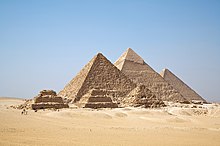
MÖ 525'te II. Kambises liderliğindeki Ahameniş İmparatorluğu Mısır akınlarına başladı ve sonunda Pelusium savaşında firavun III. Psamtik esir düştü. II. Kambises daha sonra resmî olarak firavun unvanını aldı ancak Mısır'ı günümüzde İran sınırları içinde yer alan Susa'daki evinden yöneterek Mısır'ı bir satraplığın kontrolü altına bıraktı. Ahamenişlere karşı geçici olarak başarılı olan birkaç isyan MÖ 5. yüzyıla damgasını vursa da Mısır hiçbir zaman Ahamenişleri kalıcı olarak devirmeyi başaramadı.[43]
Otuzuncu hanedan, Firavunlar döneminde hüküm süren son yerli hanedan olma özelliğini taşımaktadır. Mısır, son yerli Firavun Kral II. Nektanebo'nun savaşta yenilmesinden sonra MÖ 343'te yeniden Ahamenişlerin eline geçti. Mısır'daki bu hanedanlık uzun ömürlü değildi çünkü Ahamenişler birkaç on yıl sonra Büyük İskender tarafından devrildi. İskender'in Makedon generali I. Ptolemaios burada Ptolemaios Hanedanı'nı kurdu.[44]

Ptolemaios ve Roma Mısırı[değiştir | kaynağı değiştir]

Ptolemaios Krallığı doğuda Güney Suriye'den batıda Kirene'ye ve güneyde Nübye sınırına kadar uzanan güçlü bir Helenistik devletti. Başkent ve ülke merkezi İskenderiye oldu. Bu süre içinde Mısır'da ekonomik ve mimari gelişmeler yaşandı. Bunun yanında Roma-Mısır kültürü kaynaşması da oldu. Yunan mimarisi ve kültürü, Mısır'a ulaştı. Ptolemaioslar Yerli Mısır halkı tarafından benimsenmek amacıyla kendilerini Firavunların vârisleri olarak adlandırdılar. Mısır geleneklerini benimsediler, kendilerini Mısır tarzı ve kıyafetiyle halka açık anıtlarda resmettirdiler ve Mısırlıların dinî yaşamına katıldılar.[45][46]
Ptolemaios soyunun son hükümdarı, Octavianus'un İskenderiye'yi ele geçirmesi ve paralı askerlerinin kaçması ile birlikte sevgilisi Marcus Antonius'un ölümünün ardından intihar eden VII. Kleopatra'ydı. Ptolemaioslar sık sık yerli Mısırlıların isyanlarıyla karşı karşıya kaldılar ve krallığın gerilemesine ve Roma tarafından ilhak edilmesine yol açan dış ve iç savaşlara karıştılar.
Hristiyanlık, 1. yüzyılda Evanjelist Markos ile birlikte Mısır'a geldi.[47] Diocletianus'un hükümdarlığı (MS 284-305), Mısır'da çok sayıda Mısırlı Hristiyan'ın zulme uğradığı Roma döneminden Bizans dönemine geçişi işaret ediyordu. O zamana kadar Yeni Ahit Mısır diline tercüme edilmişti. MS 451'deki Kalkedon Konsili'nden sonra, ayrı bir Mısır Kıptî Kilisesi kuruldu.[48]
Orta Çağ (7. yüzyıl - 1517)[değiştir | kaynağı değiştir]

Bizanslılar, 602-628 Bizans-Sasani Savaşı'nın ortasında, 7. yüzyılın başlarında kısa bir Sasani istilasının ardından ülkenin kontrolünü yeniden ele geçirmeyi başardılar ve bu sırada on yıl boyunca Sasani Mısır olarak bilinen kısa ömürlü yeni bir eyalet kurdular. Bu eyalet Mısır'ın Araplar tarafından fethine kadar sürdü. Araplar Mısır'da Bizans ordularını mağlup edince İslam Mısır'da yayılmaya başladı. Bu dönemde bir süre Mısırlılar yeni inançlarını yerli inanç ve uygulamalarla harmanlamaya başladılar ve bu da bugüne kadar gelişen çeşitli Sufi tarikatlarının oluşmasına yol açtı. Bu dönemde bir süre Mısırlılar yeni inançlarını yerli inanç ve uygulamalarla harmanlamaya başladılar ve bu da bugüne kadar gelişen çeşitli Sûfî tarikatlarının oluşmasına yol açtı.[47]
Mısır üzerine 639'da yürüyen Amr bin Âs komutasındaki Arap kuvvetleri delta bölgesinin doğusundaki direnişi kırarak 641'de Doğu Roma İmparatorluğu'nu (Bizans) barış yapmaya zorladı. Bizans kuvvetlerinin geri çekilmesinden sonra 8 Kasım 641'de İskenderiye de Arapların eline geçti. İskenderiye 645'te Bizans İmparatorluğu kuvvetleri tarafından geri alındı ancak 646'da Amr tarafından tekrar Arapların eline geçti. 654 yılında II. Konstans'ın gönderdiği istila filosu geri püskürtüldü.
İlk Arap yerleşimi olarak Nil'in doğu kıyısında kurulan el-Fustat uzun süre tek Müslüman merkezi olarak kaldı. Şehir daha sonra Haçlı Seferleri sırasında yakıldı. Kahire daha sonra 986 yılında Arap halifeliğinin Bağdat'tan sonra ikinci en büyük ve en zengin şehri olması amacıyla inşa edildi.
Abbâsîler dönemi[değiştir | kaynağı değiştir]
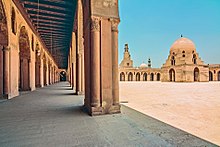
Abbâsîler döneminde yeni vergiler getirildi ve Kıptîler, Abbâsî yönetiminin dördüncü yılında isyan çıkardı. 9. yüzyılın başlarında Mısır'ı bir vali aracılığıyla yönetme uygulaması, Bağdat'ta ikamet etmeye karar veren ve kendisi adına yönetmesi için Mısır'a bir vekil gönderen Abdullah ibn Tahir döneminde yeniden başladı. 828'de Mısır'da başka bir isyan daha patlak verdi ve 831'de Kıptîler hükûmete karşı yerli Müslümanlarla birlik kurdu.
Bağdat'taki halifelik merkezinden Mısır'ı yönetme güçlüğü sonraki yıllarda sık sık vali değişikliğine başvurmaya yol açtı. IX. Yüzyılın ortalarından itibaren Bağdat tarafından gönderilen valilerin yerini valiliklerini Bağdat'a tasdik ettiren Türk komutanlar aldı. Itah (Aytah) Türkî (847-848), Hakan oğlu el-Fethi't-Türkî (856-861), Dinar oğlu Yezidi't-Türkî (856-867), Müzahimü't-Türkî (867-868), Ahmedü' Türkî (868) ve Uluğ Tarhan oğlu Uzcur Türkî (868) Sudan ile birlikte Mısır'a valilik yapan ilk altı Türk komutandır. 15 Eylül 868'de bir başka Türk vali Ahmed bin Tolun Mısır'a gelerek Mısır'da ilk Türk hanedanını kurmuştur.
Fâtımîler, Eyyûbîler ve Memlûkler[değiştir | kaynağı değiştir]
Sonraki altı yüzyıl boyunca Mısır'ın kontrolü Müslüman yöneticilerde kaldı. Kahire, Fâtımîler'in merkeziydi. Eyyûbîler hanedanının sona ermesiyle birlikte, Türk-Çerkes askerî kastı olan Memlûkler 1250 yılı civarında kontrolü ele geçirdi. 13. yüzyılın sonlarında Mısır, Kızıldeniz, Hindistan, Malaya ve Doğu Hint Adaları'nı birbirine bağladı.[49] 14. yüzyılın ortalarında Kara Ölüm, ülke nüfusunun yaklaşık %40'ının ölümüne sebep oldu.[50]

Erken modern dönem: Osmanlı dönemi (1517 - 1867)[değiştir | kaynağı değiştir]

1517 yılında Yavuz Sultan Selim'in Ridaniye Muharebesi'yle Memlûk Sultanlığı'nı yıkarak Mısır'ı Osmanlı topraklarına katması sonucunda Mısır Eyaleti kuruldu, halifelik de Türklere geçti.
Savunma amaçlı militarizasyon sivil toplum yapısına ve ekonomik kurumlara zarar verdi.[49] Ekonomik sistemin zayıflaması vebanın etkileriyle birleşerek Mısır'ı yabancı işgaline karşı savunmasız bıraktı. Portekizli tüccarlar ticareti devraldı.[49] 1687 ile 1731 yılları arasında Mısır'da altı adet kıtlık yaşandı.[52] 1784'teki kıtlık, nüfusunun yaklaşık altıda birine mal oldu.[53]
Mısır, ülkeyi yüzyıllardır yöneten Memlûklerin devam eden gücü ve etkisi nedeniyle, Osmanlı padişahları için çoğu zaman kontrol edilmesi zor bir eyalet olmuştur.
Mısır, 1798'de Napolyon Bonapart'ın Fransız kuvvetleri tarafından işgal edilene kadar Memlûk yönetimi altında yarı özerk olarak kaldı. Fransızların İngilizlere yenilmesinin ardından Osmanlı Türkleri, yüzyıllarca Mısır'ı yöneten Mısırlı Memlûkler ve Osmanlı'nın hizmetinde olan Arnavut paralı askerleri arasında üçlü bir iktidar mücadelesi yaşandı.

Kavalalılar Hanedanı dönemi[değiştir | kaynağı değiştir]

Fransızların sınır dışı edilmesinin ardından, 1805 yılında Mısır'daki Osmanlı ordusunun Arnavut kökenli askerî komutanı Mehmed Ali Paşa tarafından iktidara el konuldu. Muhammed Ali, Memlûkleri katletti ve 1952 devrimine kadar Mısır'ı yönetecek bir hanedan kurdu.
Mehmed Ali Paşa, Kuzey Sudan'ı (1820-1824), Suriye'yi (1833) ve Arabistan ile Anadolu'nun bazı kısımlarını ilhak etti. 1841'de Avrupalı güçler, Osmanlı İmparatorluğu'nu devirme ihtimalinden çekinerek Kavalalı'yı fethettiği yerlerin çoğunu Osmanlılara iade etmeye zorladı. Askeriyeye olan tutkusu onu ülkeyi modernleştirmeye zorladı. Sanayiler inşa etti, sulama ve ulaşım için bir kanal sistemi kurdu ve kamu hizmetinde reform yaptı.[55]
Mısır'ı Osmanlı İmparatorluğu'nda güçlü bir konuma yükseltmek için, 20. yüzyılda yürütülen komünizm harici Sovyet stratejileriyle çeşitli benzerlikler gösterecek şekilde, halkın yaklaşık yüzde 4'ünün orduya hizmet ettiği bir askerî devlet inşa etti.[56]
Mehmed Ali Paşa, orduyu angarya geleneği altında toplanan bir ordudan büyük, modern bir orduya dönüştürdü. 19. yüzyıl Mısır'ında erkek köylülerin zorunlu askerliğini başlattı ve büyük ordusunu desteklemek için yeni bir yaklaşım benimseyerek onu sayı ve beceri açısından güçlendirdi. Yeni askerlerin eğitim ve öğretimi zorunlu hale getirildi. Erkekler, olası aksi bir durumun önüne geçebilinmesi amacıyla kışlalarda tutuldu. Erkeklerde askerî yaşam tarzına yönelik karşıtlık zamanla azaldı ve milliyetçiliğe dayalı yeni bir ideoloji benimsendi. Mehmed Ali Paşa, bu yeni doğan askerî birliğin yardımıyla Mısır'daki hakimiyetini güçlendirdi.[57]
Mehmed Ali Paşa'nın hükümdarlığı sırasında izlediği bu politika, ileri eğitime yatırımın yalnızca askerî ve sanayi alanında gerçekleşmesi nedeniyle Mısır'daki sayısal becerinin diğer Kuzey Afrika ve Orta Doğu ülkeleriyle karşılaştırıldığında neden dikkate değer derecede küçük bir oranda arttığını kısmen açıklamaktadır.[58]
Muhammed Ali'nin yerine kısa süreliğine oğlu İbrahim (Eylül 1848'de), ardından torunu I. Abbas (Kasım 1848'de), ardından Said (1854'te) ve Mısır'da bilimi ve tarımı teşvik eden ve köleliği yasaklayan İsmail (1863'te) geçti.[56]
Mısır Hidivliği (1867-1914)[değiştir | kaynağı değiştir]
Mehmed Ali hanedanı yönetimindeki Mısır, bir Osmanlı vilayeti olarak kaldı. 1867'de özerk bir vasal devlet veya Hidivlik statüsü verildi. 1867'de özerk bir vasal devlet (Hidivlik) statüsü verildi.
Fransızlarla ortaklaşa inşa edilen Süveyş Kanalı 1869'da tamamlandı. İnşaatı Avrupalı bankalar tarafından finanse edildi. Himaye ve yolsuzluğa da büyük meblağlar gitmiştir. Yeni vergiler halkın hoşnutsuzluğuna neden oldu. 1875'te İsmail Paşa, Mısır'ın kanaldaki tüm hisselerini İngiliz hükûmetine satarak iflastan kurtuldu. Üç yıl içinde bu, Mısır kabinesinde yer alan ve "tahvil sahiplerinin mali gücünün arkalarında olmasıyla hükümetteki gerçek güç olan" İngiliz ve Fransız kontrolörlerin göreve getirilmesine yol açtı.[59]
Salgın hastalıklar (1880'lerdeki sığır hastalığı), su baskınları ve savaşlar gibi diğer koşullar ekonomik gerilemeyi tetikledi ve Mısır'ın dış borca bağımlılığını daha da artırdı.[60]
Hidiv'den ve Avrupa'nın müdahalesinden duyulan memnuniyetsizlik, 1879'da ilk milliyetçi grupların oluşmasına yol açtı. Ahmed Urabi öne çıkan isimlerden biri idi. Artan gerginlikler ve milliyetçi isyanların ardından Birleşik Krallık, 1882'de Mısır'ı işgal etti. Tell El Kebir Muharebesi'nde Mısır ordusunu ezdi ve ülkeyi askerî olarak fiilen işgal etti.[61] Bunu takiben Hidivlik, sözde Osmanlı egemenliği altında fiili bir İngiliz himayesi haline geldi.[62]
1899'da İngiliz-Mısır Kat Mülkiyeti Anlaşması imzalandı. Anlaşma, Sudan'ın Mısır Hidivliği ve Birleşik Krallık tarafından ortaklaşa yönetileceğini belirtiyordu. Ancak Sudan'ın fiili kontrolü yalnızca İngilizlerin elindeydi.
1906'da Denişvay Olayı birçok tarafsız Mısırlının milliyetçi harekete katılmasına neden oldu.
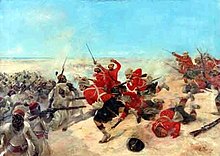
Mısır Sultanlığı (1914-1922)[değiştir | kaynağı değiştir]

1914'te Osmanlı İmparatorluğu, merkezi imparatorluklarla ittifak halinde Birinci Dünya Savaşı'na resmen girdi. Önceki yıllarda İngilizlere giderek daha fazla düşmanlık geliştiren Hidiv II. Abbas savaşta anavatana destek olmaya karar verdi. Bu kararın ardından İngilizler zorla iktidarına son verdi ve yerine kardeşi Hüseyin Kâmil'i getirdi.[63][64]
Hüseyin Kâmil, Mısır Sultanı unvanını alarak Mısır'ın Osmanlı İmparatorluğu'ndan bağımsızlığını ilan etti. Bağımsızlığın hemen ardından Mısır, Birleşik Krallık'ın himayesi altına alındı.
Birinci Dünya Savaşı'ndan sonra Sad Zağlûl ve Vefd Partisi, Mısır milliyetçi hareketini yerel Yasama Meclisi'nde çoğunluğa kavuşturdu. İngilizler 8 Mart 1919'da Zağlûl ve arkadaşlarını Malta'ya sürgün ettiğinde ülke ilk modern devrimini yaşadı. İsyan, Birleşik Krallık hükûmetinin 22 Şubat 1922'de Mısır'ın bağımsızlığını tek taraflı olarak ilan etmesine yol açtı.[65]
Mısır Krallığı (1922-1953)[değiştir | kaynağı değiştir]
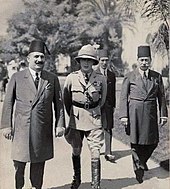
Birleşik Krallık'tan bağımsızlığını kazandıktan sonra Sultan I. Fuad, Mısır Kralı unvanını aldı. Sözde bağımsız olmasına rağmen, krallık fiilen hâlâ İngiliz işgali altındaydı ve Birleşik Krallık'ın hâlâ devlet üzerinde büyük etkisi vardı.
Yeni hükûmet 1923 yılında parlamenter sisteme dayalı bir anayasa hazırlayıp uygulamaya koydu. Milliyetçi Vefd Partisi 1923-1924 seçimlerinde ezici bir çoğunlukla zafer kazandı ve Sad Zağlûl yeni başbakan olarak atandı.
1936'da İngiliz-Mısır Antlaşması imzalandı ve İngiliz birlikleri Süveyş Kanalı hariç Mısır'dan çekildi. Anlaşma, mevcut 1899 İngiliz-Mısır Kat Mülkiyeti Anlaşması hükümlerine göre Sudan'ın Mısır ve İngiltere tarafından ortaklaşa yönetilmesi gerektiğini ancak gerçek gücün İngilizlerin elinde kalması gerektiğini belirten Sudan sorununa çözüm bulmadı.[66]
Britanya, Mısır'ı bölgedeki Müttefik operasyonları için, özellikle de Kuzey Afrika'da İtalya ve Almanya'ya karşı yapılan savaşlar için bir üs olarak kullandı. En büyük öncelikleri Doğu Akdeniz'in kontrolü ve özellikle Süveyş Kanalı'nın ticari gemilere ve Hindistan ve Avustralya ile askerî bağlantılara açık tutulmasıydı. Eylül 1939'da savaş başladığında Mısır sıkıyönetim ilan etti ve Almanya ile diplomatik ilişkilerini kesti. 1940 yılında İtalya ile diplomatik ilişkilerini kesti ancak İtalyan ordusu Mısır'ı işgal ettiğinde bile asla savaş ilan etmedi. Mısır ordusu savaşmadı. Haziran 1940'ta Kral, İngilizlerle arası iyi olmayan Başbakan Ali Mahir'i görevden aldı. Bağımsız Hasan Paşa Sabri'nin başbakanlığında yeni bir koalisyon hükûmeti kuruldu.

Şubat 1942'deki bakanlık krizinin ardından, Büyükelçi Miles Lampson, Faruk'a, Hüseyin Sırrı Paşa hükümetinin yerine bir Vefd veya Vefd koalisyon hükümeti kurması için baskı yaptı. 4 Şubat 1942 gecesi İngiliz birlikleri ve tankları Kahire'deki Abidin Sarayı'nı kuşattı ve Lampson, Faruk'a bir ültimatom sundu. Faruk teslim oldu ve Nehhas kısa süre sonra hükümeti kurdu.
İngiliz ordusunun bölgede bir askerî üssü olmasına rağmen İngiliz birliklerinin çoğu 1947'de Süveyş Kanalı bölgesine çekildi. Ülkedeki milliyetçi, İngiliz karşıtı duygular savaştan sonra büyümeye devam etti. Krallığın Birinci Arap-İsrail Savaşı'ndaki talihsiz performansının ardından monarşi karşıtı duygular daha da arttı. 1950 seçimleri milliyetçi Vefd Partisi'nin ezici bir zaferine tanık oldu ve Kral, Mustafa Nehhas Paşa'yı yeni başbakan olarak atamak zorunda kaldı. 1951'de Mısır, 1936 İngiliz-Mısır Antlaşması'ndan tek taraflı olarak çekildi ve geri kalan tüm İngiliz birliklerinin Süveyş Kanalı'nı terk etmesini emretti.
İngilizlerin Süveyş Kanalı çevresindeki üslerini terk etmeyi reddetmesi üzerine Mısır hükümeti suyu kesti ve Süveyş Kanalı üssüne yiyecek tedarikine izin vermedi, İngiliz mallarına boykot ilan etti, Mısırlı işçilerin üsse girmesini yasakladı ve gerilla saldırılarına destek oldu. 24 Ocak 1952'de Mısır gerillaları Süveyş Kanalı çevresinde İngiliz kuvvetlerine şiddetli bir saldırı düzenlerken Mısır polisinin gerillalara yardım ettiği görüldü. Buna cevaben 25 Ocak'ta General George Erskine, İsmailiye'deki polis karakolunun çevrelenmesi için İngiliz tanklarını ve piyadelerini gönderdi. Polis komutanı, Nehhas'ın sağ kolu olan İçişleri Bakanı Fuad Serageddin'i arayarak teslim mi olması yoksa savaşması mı gerektiğini sordu. Serageddin polise "son adama ve son kurşuna kadar" savaşma emri verdi. Ortaya çıkan çatışmada polis karakolu yerle bir edildi ve 43 Mısırlı polis memuru ile 3 İngiliz askeri öldürüldü. İsmailiye olayı Mısır'ı öfkelendirdi. Ertesi gün, 26 Ocak 1952, İngiliz karşıtı isyan olarak bilinen "Kara Cumartesi" olarak tarihe geçti Kanuni Hidiv İsmail'in Paris tarzında yeniden inşa ettiği Kahire şehir merkezinin büyük bir kısmının yanmasına neden oldu. Faruk, Kara Cumartesi isyanından Vefd'i sorumlu tuttu ve ertesi gün Nehhas'ı başbakanlıktan uzaklaştırdı. Yerine Ali Mahir Paşa getirildi.[67]
22-23 Temmuz 1952'de Muhammed Necib ve Cemal Abdülnasır liderliğindeki Hür Subaylar Hareketi, krala karşı bir darbe (1952 Mısır Devrimi) başlattı. I. Faruk, tahtını o sırada yedi aylık bir bebek olan oğlu II. Fuad'a bıraktı. Kraliyet Ailesi birkaç gün sonra Mısır'ı terk etti ve Prens Muhammed Abdülmünim liderliğindeki Vekillik Konseyi kuruldu. Ancak konsey yalnızca nominal yetkiye sahipti ve gerçek güç aslında Necib ve Abdülnasır liderliğindeki Devrimci Komuta Konseyi'nin elindeydi.
Acil reformlara yönelik popüler beklentiler, 12 Ağustos 1952'de Kafr ed-Davvar'da işçi ayaklanmalarına yol açtı. Sivil yönetimle ilgili kısa bir deneyin ardından Hür Subaylar, monarşiyi ve 1923 anayasasını kaldırdı ve 18 Haziran 1953'te Mısır'da cumhuriyeti ilan etti. Necib cumhurbaşkanı ilan edilirken Abdülnasır yeni başbakan olarak atandı.
XXXXXXXXXXXXXXXXXXXXXXXXXXXXXXXXXXXXXXXXXXXXXXXXXXXXXXXXXXXXXXXXXXXX
Republic of Egypt (1953–1958)[değiştir | kaynağı değiştir]
Following the 1952 Revolution by the Free Officers Movement, the rule of Egypt passed to military hands and all political parties were banned. On 18 June 1953, the Egyptian Republic was declared, with General Muhammad Naguib as the first President of the Republic, serving in that capacity for a little under one and a half years.
President Nasser (1956–1970)[değiştir | kaynağı değiştir]

Naguib was forced to resign in 1954 by Gamal Abdel Nasser – a Pan-Arabist and the real architect of the 1952 movement – and was later put under house arrest. After Naguib's resignation, the position of President was vacant until the election of Nasser in 1956.[68]
In October 1954, Egypt and the United Kingdom agreed to abolish the Anglo-Egyptian Condominium Agreement of 1899 and grant Sudan independence; the agreement came into force on 1 January 1956.
Nasser assumed power as president in June 1956. British forces completed their withdrawal from the occupied Suez Canal Zone on 13 June 1956. He nationalised the Suez Canal on 26 July 1956; his hostile approach towards Israel and economic nationalism prompted the beginning of the Second Arab-Israeli War (Suez Crisis), in which Israel (with support from France and the United Kingdom) occupied the Sinai peninsula and the Canal. The war came to an end because of US and USSR diplomatic intervention and the status quo was restored.
United Arab Republic (1958–1971)[değiştir | kaynağı değiştir]
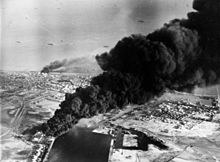
In 1958, Egypt and Syria formed a sovereign union known as the United Arab Republic. The union was short-lived, ending in 1961 when Syria seceded, thus ending the union. During most of its existence, the United Arab Republic was also in a loose confederation with North Yemen (or the Mutawakkilite Kingdom of Yemen), known as the United Arab States.
In the early 1960s, Egypt became fully involved in the North Yemen Civil War. Despite several military moves and peace conferences, the war sank into a stalemate.[69]
In mid May 1967, the Soviet Union issued warnings to Nasser of an impending Israeli attack on Syria. Although the chief of staff Mohamed Fawzi verified them as "baseless",[70][71] Nasser took three successive steps that made the war virtually inevitable: on 14 May he deployed his troops in Sinai near the border with Israel, on 19 May he expelled the UN peacekeepers stationed in the Sinai Peninsula border with Israel, and on 23 May he closed the Straits of Tiran to Israeli shipping.[72] On 26 May Nasser declared, "The battle will be a general one and our basic objective will be to destroy Israel".[73]
This prompted the beginning of the Third Arab Israeli War (Six-Day War) in which Israel attacked Egypt, and occupied Sinai Peninsula and the Gaza Strip, which Egypt had occupied since the 1948 Arab–Israeli War. During the 1967 war, an Emergency Law was enacted, and remained in effect until 2012, with the exception of an 18-month break in 1980/81.[74] Under this law, police powers were extended, constitutional rights suspended and censorship legalised.[75]
At the time of the fall of the Egyptian monarchy in the early 1950s, less than half a million Egyptians were considered upper class and rich, four million middle class and 17 million lower class and poor.[76] Fewer than half of all primary-school-age children attended school, most of them being boys. Nasser's policies changed this. Land reform and distribution, the dramatic growth in university education, and government support to national industries greatly improved social mobility and flattened the social curve. From academic year 1953–54 through 1965–66, overall public school enrolments more than doubled. Millions of previously poor Egyptians, through education and jobs in the public sector, joined the middle class. Doctors, engineers, teachers, lawyers, journalists, constituted the bulk of the swelling middle class in Egypt under Nasser.[76] During the 1960s, the Egyptian economy went from sluggish to the verge of collapse, the society became less free, and Nasser's appeal waned considerably.[77]
Arab Republic of Egypt (1971–present)[değiştir | kaynağı değiştir]
President Sadat (1970–1981)[değiştir | kaynağı değiştir]

In 1970, President Nasser died and was succeeded by Anwar Sadat. Sadat switched Egypt's Cold War allegiance from the Soviet Union to the United States, expelling Soviet advisors in 1972. He launched the Infitah economic reform policy, while clamping down on religious and secular opposition. In 1973, Egypt, along with Syria, launched the Fourth Arab-Israeli War (Yom Kippur War), a surprise attack to regain part of the Sinai territory Israel had captured 6 years earlier.

In 1975, Sadat shifted Nasser's economic policies and sought to use his popularity to reduce government regulations and encourage foreign investment through his programme of Infitah. Through this policy, incentives such as reduced taxes and import tariffs attracted some investors, but investments were mainly directed at low risk and profitable ventures like tourism and construction, abandoning Egypt's infant industries.[78] Because of the elimination of subsidies on basic foodstuffs, it led to the 1977 Egyptian Bread Riots.
Sadat made a historic visit to Israel in 1977, which led to the 1979 Egypt-Israel peace treaty in exchange for Israeli withdrawal from Sinai. In return, Egypt recognised Israel as a legitimate sovereign state. Sadat's initiative sparked enormous controversy in the Arab world and led to Egypt's expulsion from the Arab League, but it was supported by most Egyptians.[79] Sadat was assassinated by an Islamic extremist in October 1981.
President Mubarak (1981–2011)[değiştir | kaynağı değiştir]
Hosni Mubarak came to power after the assassination of Sadat in a referendum in which he was the only candidate.[80] Hosni Mubarak reaffirmed Egypt's relationship with Israel yet eased the tensions with Egypt's Arab neighbours. Domestically, Mubarak faced serious problems. Mass poverty and unemployment led rural families to stream into cities like Cairo where they ended up in crowded slums, barely managing to survive.
On 25 February 1986, the Security Police started rioting, protesting against reports that their term of duty was to be extended from 3 to 4 years. Hotels, nightclubs, restaurants and casinos were attacked in Cairo and there were riots in other cities. A day time curfew was imposed. It took the army 3 days to restore order. 107 people were killed.[81]
In the 1980s, 1990s, and 2000s, terrorist attacks in Egypt became numerous and severe, and began to target Christian Copts, foreign tourists and government officials.[82] In the 1990s an Islamist group, Al-Gama'a al-Islamiyya, engaged in an extended campaign of violence, from the murders and attempted murders of prominent writers and intellectuals, to the repeated targeting of tourists and foreigners. Serious damage was done to the largest sector of Egypt's economy—tourism[83]—and in turn to the government, but it also devastated the livelihoods of many of the people on whom the group depended for support.[84]
During Mubarak's reign, the political scene was dominated by the National Democratic Party, which was created by Sadat in 1978. It passed the 1993 Syndicates Law, 1995 Press Law, and 1999 Nongovernmental Associations Law which hampered freedoms of association and expression by imposing new regulations and draconian penalties on violations.[85] As a result, by the late 1990s parliamentary politics had become virtually irrelevant and alternative avenues for political expression were curtailed as well.[86]

On 17 November 1997, 62 people, mostly tourists, were massacred near Luxor.
In late February 2005, Mubarak announced a reform of the presidential election law, paving the way for multi-candidate polls for the first time since the 1952 movement.[87] However, the new law placed restrictions on the candidates, and led to Mubarak's easy re-election victory.[88] Voter turnout was less than 25%.[89] Election observers also alleged government interference in the election process.[90] After the election, Mubarak imprisoned Ayman Nour, the runner-up.[91]
Human Rights Watch's 2006 report on Egypt detailed serious human rights violations, including routine torture, arbitrary detentions and trials before military and state security courts.[92] In 2007, Amnesty International released a report alleging that Egypt had become an international centre for torture, where other nations send suspects for interrogation, often as part of the War on Terror.[93] Egypt's foreign ministry quickly issued a rebuttal to this report.[94]
Constitutional changes voted on 19 March 2007 prohibited parties from using religion as a basis for political activity, allowed the drafting of a new anti-terrorism law, authorised broad police powers of arrest and surveillance, and gave the president power to dissolve parliament and end judicial election monitoring.[95] In 2009, Dr. Ali El Deen Hilal Dessouki, Media Secretary of the National Democratic Party (NDP), described Egypt as a "pharaonic" political system, and democracy as a "long-term goal". Dessouki also stated that "the real center of power in Egypt is the military".[kaynak belirtilmeli]
Revolution (2011)[değiştir | kaynağı değiştir]
Bottom: protests in Tahrir Square against President Morsi on 27 November 2012.
On 25 January 2011, widespread protests began against Mubarak's government. On 11 February 2011, Mubarak resigned and fled Cairo. Jubilant celebrations broke out in Cairo's Tahrir Square at the news.[96] The Egyptian military then assumed the power to govern.[97][98] Mohamed Hussein Tantawi, chairman of the Supreme Council of the Armed Forces, became the de facto interim head of state.[99][100] On 13 February 2011, the military dissolved the parliament and suspended the constitution.[101]
A constitutional referendum was held on 19 March 2011.[102] On 28 November 2011, Egypt held its first parliamentary election since the previous regime had been in power. Turnout was high and there were no reports of major irregularities or violence.[103]
President Morsi (2012–2013)[değiştir | kaynağı değiştir]
Mohamed Morsi was elected president on 24 June 2012.[104] On 30 June 2012, Mohamed Morsi was sworn in as Egypt's president.[105] On 2 August 2012, Egypt's Prime Minister Hisham Qandil announced his 35-member cabinet comprising 28 newcomers, including four from the Muslim Brotherhood.[106]
Liberal and secular groups walked out of the constituent assembly because they believed that it would impose strict Islamic practices, while Muslim Brotherhood backers threw their support behind Morsi.[107] On 22 November 2012, President Morsi issued a temporary declaration immunising his decrees from challenge and seeking to protect the work of the constituent assembly.[108]
The move led to massive protests and violent action throughout Egypt.[109] On 5 December 2012, tens of thousands of supporters and opponents of President Morsi clashed, in what was described as the largest violent battle between Islamists and their foes since the country's revolution.[110] Mohamed Morsi offered a "national dialogue" with opposition leaders but refused to cancel the December 2012 constitutional referendum.[111]
Political crisis (2013)[değiştir | kaynağı değiştir]
On 3 July 2013, after a wave of public discontent with autocratic excesses of Morsi's Muslim Brotherhood government,[112] the military removed Morsi from office, dissolved the Shura Council and installed a temporary interim government.[113]
On 4 July 2013, 68-year-old Chief Justice of the Supreme Constitutional Court of Egypt Adly Mansour was sworn in as acting president over the new government following the removal of Morsi.[114] The new Egyptian authorities cracked down on the Muslim Brotherhood and its supporters, jailing thousands and forcefully dispersing pro-Morsi and pro-Brotherhood protests.[115][116] Many of the Muslim Brotherhood leaders and activists have either been sentenced to death or life imprisonment in a series of mass trials.[117][118][119]
On 18 January 2014, the interim government instituted a new constitution following a referendum approved by an overwhelming majority of voters (98.1%). 38.6% of registered voters participated in the referendum[120] a higher number than the 33% who voted in a referendum during Morsi's tenure.[121]
President el-Sisi (2014–present)[değiştir | kaynağı değiştir]

On 26 March 2014, Field Marshal Abdel Fattah el-Sisi, Egyptian Defence Minister and Commander-in-Chief Egyptian Armed Forces, retired from the military, announcing he would stand as a candidate in the 2014 presidential election.[122] The poll, held between 26 and 28 May 2014, resulted in a landslide victory for el-Sisi.[123] Sisi was sworn into office as President of Egypt on 8 June 2014.[124] The Muslim Brotherhood and some liberal and secular activist groups boycotted the vote.[125] Even though the interim authorities extended voting to a third day, the 46% turnout was lower than the 52% turnout in the 2012 election.[126]
A new parliamentary election was held in December 2015, resulting in a landslide victory for pro-Sisi parties, which secured a strong majority in the newly formed House of Representatives.[127]
In 2016, Egypt entered in a diplomatic crisis with Italy following the murder of researcher Giulio Regeni: in April 2016, Prime Minister Matteo Renzi recalled the Italian ambassador from Cairo because of lack of co-operation from the Egyptian Government in the investigation.[128] The ambassador was sent back to Egypt in 2017 by the new Prime Minister Paolo Gentiloni.[129]
El-Sisi was re-elected in 2018, facing no serious opposition.[130] In 2019, a series of constitutional amendments were approved by the parliament, further increasing the President's and the military's power, increasing presidential terms from 4 years to 6 years, and allowing incumbent president El-Sisi to run for an additional third term.[131] The proposals were approved in a referendum.[132]
The dispute between Egypt and Ethiopia over the Grand Ethiopian Renaissance Dam escalated in 2020.[133][134] Egypt sees the dam as an existential threat,[135] fearing that the dam will reduce the amount of water it receives from the Nile.[136]
In December 2020, final results of the parliamentary election confirmed a clear majority of the seats for Egypt's Mostaqbal Watn (Nation's Future) Party, which strongly supports president el-Sisi. The party even increased its majority, partly because of new electoral rules.[137]
In December 2023, el-Sisi won the 2023 presidential election with 89.6% of the vote, and was re-elected to an additional third term that lasts until 2030. The official turnout was 66.8%, the highest of any Egyptian presidential election since 2012.[138]
Geography[değiştir | kaynağı değiştir]

Egypt's geography is unique and complex, marked by a variety of landforms. The nation spans latitudes 22° to 32°N and longitudes 25° to 35°E, encompassing 1,001,450 square kilometers, making it the world's 30th-largest country. It is distinguished primarily by its expansive deserts, covering about 96% of the land area. This arid landscape offers a harsh environment, with prolific sand dunes that can reach over 30 meters in height. Within the vast desert expanses are a few scattered oases such as Bahariya, Dakhla, Farafra, Kharga, and Siwa.
The population of Egypt is heavily concentrated along the Nile Valley and Delta due to the extreme aridity of its climate. Around 99% of the people inhabit approximately 5.5% of the total land area, with 98% living on just 3% of the territory. The life-giving Nile River not only fosters this dense human habitation but also creates a striking contrast in the landscape as its lush riverbanks carve a path through the desert. In ancient times and even today, the Nile's crucial role in supporting life makes it an object of reverence.
Aside from the Nile Valley, Egypt features the Sinai Peninsula, a land bridge connecting Africa to Asia bordered by Libya to the west; Sudan to the south; and the Gaza Strip and Israel to the east. Sinai hosts Mount Catherine at 2,642 meters above sea level—Egypt's highest peak—and boasts the Red Sea Riviera on its east side with abundant coral reefs and marine life.
Egypt is also home to significant water bodies, including two critical seas—Mediterranean and Red—that provide food resources and economic opportunities through trade routes. The Suez Canal is an essential waterway that pierces through Egypt's western terrain connecting these two seas while facilitating international maritime trade between Europe and Asia.
Major urban centers reflect cultural and historical richness: Cairo as the modern capital; Alexandria as the second-largest city; Luxor and Giza with their archaeological significance; and newer hubs like Sharm El Sheikh on the scenic coastlines. Protectorates such as Ras Mohamed National Park preserve ecological biodiversity in addition to cultural landmarks.
The strategic importance of geographical features like the Sinai Peninsula is underscored by its linkage between continents via Isthmus of Suez. Here lies a navigable waterway—the Suez Canal—trekking between Mediterranean Sea and Indian Ocean through Red Sea, symbolizing Egypt's economic vitality.
On March 13th, 2015 plans were unveiled for a proposed new capital aiming to further shape Egypt's urban landscape while acknowledging existing towns such as El Mahalla El Kubra, Aswan, Hurghada among others in this transcontinental nation's diverse topography.
-
Egypt lies primarily between latitudes 22° and 32°N, and longitudes 25° and 35°E. At 1.001.450 kilometrekare (386.660 sq mi), it is the world's 30th-largest country.[139] Due to the extreme aridity of Egypt's climate, population centres are concentrated along the narrow Nile Valley and Delta, meaning that about 99% of the population uses about 5.5% of the total land area.[140] 98% of Egyptians live on 3% of the territory.[141]
Egypt is bordered by Libya to the west, the Sudan to the south, and the Gaza Strip and Israel to the east. A transcontinental nation, it possesses a land bridge (the Isthmus of Suez) between Africa and Asia, traversed by a navigable waterway (the Suez Canal) that connects the Mediterranean Sea with the Indian Ocean by way of the Red Sea.
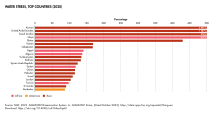
Apart from the Nile Valley, the majority of Egypt's landscape is desert, with a few oases scattered about. Winds create prolific sand dunes that peak at more than 30 metre (100 ft) high. Egypt includes parts of the Sahara desert and of the Libyan Desert.
Sinai peninsula hosts the highest mountain in Egypt, Mount Catherine at 2,642 metres. The Red Sea Riviera, on the east of the peninsula, is renowned for its wealth of coral reefs and marine life.
Towns and cities include Alexandria, the second largest city; Aswan; Asyut; Cairo, the modern Egyptian capital and largest city; El Mahalla El Kubra; Giza, the site of the Pyramid of Khufu; Hurghada; Luxor; Kom Ombo; Port Safaga; Port Said; Sharm El Sheikh; Suez, where the south end of the Suez Canal is located; Zagazig; and Minya. Oases include Bahariya, Dakhla, Farafra, Kharga and Siwa. Protectorates include Ras Mohamed National Park, Zaranik Protectorate and Siwa.
On 13 March 2015, plans for a proposed new capital of Egypt were announced.[142]
Climate[değiştir | kaynağı değiştir]

Most of Egypt's rain falls in the winter months.[143] South of Cairo, rainfall averages only around 2 ila 5 mm (0,1 ila 0,2 in) per year and at intervals of many years. On a very thin strip of the northern coast the rainfall can be as high as 410 mm (16,1 in),[144] mostly between October and March. Snow falls on Sinai's mountains and some of the north coastal cities such as Damietta, Baltim and Sidi Barrani, and rarely in Alexandria. A very small amount of snow fell on Cairo on 13 December 2013, the first time in many decades.[145] Frost is also known in mid-Sinai and mid-Egypt.
Egypt has an unusually hot, sunny and dry climate. Average high temperatures are high in the north but very to extremely high in the rest of the country during summer. The cooler Mediterranean winds consistently blow over the northern sea coast, which helps to get more moderated temperatures, especially at the height of the summertime. The Khamaseen is a hot, dry wind that originates from the vast deserts in the south and blows in the spring or in the early summer. It brings scorching sand and dust particles, and usually brings daytime temperatures over 40 °C (104 °F) and sometimes over 50 °C (122 °F) in the interior, while the relative humidity can drop to 5% or even less.
Prior to the construction of the Aswan Dam, the Nile flooded annually, replenishing Egypt's soil. This gave Egypt a consistent harvest throughout the years.
The potential rise in sea levels due to global warming could threaten Egypt's densely populated coastal strip and have grave consequences for the country's economy, agriculture and industry. Combined with growing demographic pressures, a significant rise in sea levels could turn millions of Egyptians into environmental refugees by the end of the 21st century, according to some climate experts.[146][147]
Biodiversity[değiştir | kaynağı değiştir]

Egypt signed the Rio Convention on Biological Diversity on 9 June 1992, and became a party to the convention on 2 June 1994.[148] It has subsequently produced a National Biodiversity Strategy and Action Plan, which was received by the convention on 31 July 1998.[149] Where many CBD National Biodiversity Strategy and Action Plans neglect biological kingdoms apart from animals and plants,[150]
The plan stated that the following numbers of species of different groups had been recorded from Egypt: algae (1483 species), animals (about 15,000 species of which more than 10,000 were insects), fungi (more than 627 species), monera (319 species), plants (2426 species), protozoans (371 species). For some major groups, for example lichen-forming fungi and nematode worms, the number was not known. Apart from small and well-studied groups like amphibians, birds, fish, mammals and reptiles, the many of those numbers are likely to increase as further species are recorded from Egypt. For the fungi, including lichen-forming species, for example, subsequent work has shown that over 2200 species have been recorded from Egypt, and the final figure of all fungi actually occurring in the country is expected to be much higher.[151] For the grasses, 284 native and naturalised species have been identified and recorded in Egypt.[152]
Government[değiştir | kaynağı değiştir]

The House of Representatives, whose members are elected to serve five-year terms, specialises in legislation. Elections were held between November 2011 and January 2012, which were later dissolved. The next parliamentary election was announced to be held within 6 months of the constitution's ratification on 18 January 2014, and were held in two phases, from 17 October to 2 December 2015.[153] Originally, the parliament was to be formed before the president was elected, but interim president Adly Mansour pushed the date.[154] The 2014 Egyptian presidential election took place on 26–28 May. Official figures showed a turnout of 25,578,233 or 47.5%, with Abdel Fattah el-Sisi winning with 23.78 million votes, or 96.9% compared to 757,511 (3.1%) for Hamdeen Sabahi.[155]
After a wave of public discontent with the autocratic excesses[kaynak belirtilmeli] of the Muslim Brotherhood government of President Mohamed Morsi,[112] on 3 July 2013 then-General Abdel Fattah el-Sisi announced the removal of Morsi from office and the suspension of the constitution. A 50-member constitution committee was formed for modifying the constitution, which was later published for public voting and was adopted on 18 January 2014.[156]
In 2024, as part of its Freedom in the World report, Freedom House rated political rights in Egypt at 6 (with 40 representing the most free and 0 the least), and civil liberties at 12 (with 60 being the highest score and 0 the lowest, which gave it the freedom rating of "Not Free".[157] According to the 2023 V-Dem Democracy indices Egypt is the eighth least democratic country in Africa.[158] The 2023 edition of The Economist Democracy Index categorises Egypt as an "authoritarian regime", with a score of 2.93.[159]
Egyptian nationalism predates its Arab counterpart by many decades, having roots in the 19th century and becoming the dominant mode of expression of Egyptian anti-colonial activists and intellectuals until the early 20th century.[160] The ideology espoused by Islamists such as the Muslim Brotherhood is mostly supported by the lower-middle strata of Egyptian society.[161]
Egypt has the oldest continuous parliamentary tradition in the Arab world.[162] The first popular assembly was established in 1866. It was disbanded as a result of the British occupation of 1882, and the British allowed only a consultative body to sit. In 1923, however, after the country's independence was declared, a new constitution provided for a parliamentary monarchy.[162]
Military and foreign relations[değiştir | kaynağı değiştir]

The military is influential in the political and economic life of Egypt and exempts itself from laws that apply to other sectors. It enjoys considerable power, prestige and independence within the state and has been widely considered part of the Egyptian "deep state".[80][163][164]
Egypt is speculated by Israel to be the second country in the region with a spy satellite, EgyptSat 1[165] in addition to EgyptSat 2 launched on 16 April 2014.[166]
Bottom: President Abdel Fattah el-Sisi and Russian President Vladimir Putin in Sochi, August 2014.
The United States provides Egypt with annual military assistance, which in 2015 amounted to US$1.3 billion.[167] In 1989, Egypt was designated as a major non-NATO ally of the United States.[168] Nevertheless, ties between the two countries have partially soured since the July 2013 overthrow of Islamist president Mohamed Morsi,[169] with the Obama administration denouncing Egypt over its crackdown on the Muslim Brotherhood, and cancelling future military exercises involving the two countries.[170] There have been recent attempts, however, to normalise relations between the two, with both governments frequently calling for mutual support in the fight against regional and international terrorism.[171][172][173] However, following the election of Republican Donald Trump as the President of the United States, the two countries were looking to improve the Egyptian-American relations. On 3 April 2017 al-Sisi met with Trump at the White House, marking the first visit of an Egyptian president to Washington in 8 years. Trump praised al-Sisi in what was reported as a public relations victory for the Egyptian president, and signaled it was time for a normalisation of the relations between Egypt and the US.[174]
Relations with Russia have improved significantly following Mohamed Morsi's removal[175] and both countries have worked since then to strengthen military[176] and trade ties[177] among other aspects of bilateral co-operation. Relations with China have also improved considerably. In 2014, Egypt and China established a bilateral "comprehensive strategic partnership".[178]
The permanent headquarters of the Arab League are located in Cairo and the body's secretary general has traditionally been Egyptian. This position is currently held by former foreign minister Ahmed Aboul Gheit. The Arab League briefly moved from Egypt to Tunis in 1978 to protest the Egypt–Israel peace treaty, but it later returned to Cairo in 1989. Gulf monarchies, including the United Arab Emirates[179] and Saudi Arabia,[180] have pledged billions of dollars to help Egypt overcome its economic difficulties since the overthrow of Morsi.[181]
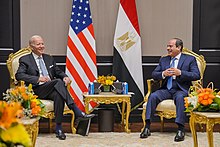
Following the 1973 war and the subsequent peace treaty, Egypt became the first Arab nation to establish diplomatic relations with Israel. Despite that, Israel is still widely considered as a hostile state by the majority of Egyptians.[182] Egypt has played a historical role as a mediator in resolving various disputes in the Middle East, most notably its handling of the Israeli–Palestinian conflict and the peace process.[183] Egypt's ceasefire and truce brokering efforts in Gaza have hardly been challenged following Israel's evacuation of its settlements from the strip in 2005, despite increasing animosity towards the Hamas government in Gaza following the ouster of Mohamed Morsi,[184] and despite recent attempts by countries like Turkey and Qatar to take over this role.[185]
Ties between Egypt and other non-Arab Middle Eastern nations, including Iran and Turkey, have often been strained. Tensions with Iran are mostly due to Egypt's peace treaty with Israel and Iran's rivalry with traditional Egyptian allies in the Gulf.[186] Turkey's recent support for the now-banned Muslim Brotherhood in Egypt and its alleged involvement in Libya also made both countries bitter regional rivals.[187]
Egypt is a founding member of the Non-Aligned Movement and the United Nations. It is also a member of the Fransızca: Organisation internationale de la francophonie, since 1983. Former Egyptian Deputy Prime Minister Boutros Boutros-Ghali served as Secretary-General of the United Nations from 1991 to 1996.
In 2008, Egypt was estimated to have two million African refugees, including over 20,000 Sudanese nationals registered with UNHCR as refugees fleeing armed conflict or asylum seekers. Egypt adopted "harsh, sometimes lethal" methods of border control.[188]
Law[değiştir | kaynağı değiştir]

The legal system is based on Islamic and civil law (particularly Napoleonic codes); and judicial review by a Supreme Court, which accepts compulsory International Court of Justice jurisdiction only with reservations.[67]
Islamic jurisprudence is the principal source of legislation. Sharia courts and qadis are run and licensed by the Ministry of Justice.[189] The personal status law that regulates matters such as marriage, divorce and child custody is governed by Sharia. In a family court, a woman's testimony is worth half of a man's testimony.[190]
On 26 December 2012, the Muslim Brotherhood attempted to institutionalise a controversial new constitution. It was approved by the public in a referendum held 15–22 December 2012 with 64% support, but with only 33% electorate participation.[191] It replaced the 2011 Provisional Constitution of Egypt, adopted following the revolution.
The Penal code was unique as it contains a "Blasphemy Law."[192] The present court system allows a death penalty including against an absent individual tried in absentia. Several Americans and Canadians were sentenced to death in 2012.[193]
On 18 January 2014, the interim government successfully institutionalised a more secular constitution.[194] The president is elected to a four-year term and may serve 2 terms.[194] The parliament may impeach the president.[194] Under the constitution, there is a guarantee of gender equality and absolute freedom of thought.[194] The military retains the ability to appoint the national Minister of Defence for the next two full presidential terms since the constitution took effect.[194] Under the constitution, political parties may not be based on "religion, race, gender or geography".[194]
Human rights[değiştir | kaynağı değiştir]
In 2003, the government established the National Council for Human Rights.[195] Shortly after its foundation, the council came under heavy criticism by local activists, who contend it was a propaganda tool for the government to excuse its own violations[196] and to give legitimacy to repressive laws such as the Emergency Law.[197]

The Pew Forum on Religion & Public Life ranks Egypt as the fifth worst country in the world for religious freedom.[198][199] The United States Commission on International Religious Freedom, a bipartisan independent agency of the US government, has placed Egypt on its watch list of countries that require close monitoring due to the nature and extent of violations of religious freedom engaged in or tolerated by the government.[200] According to a 2010 Pew Global Attitudes survey, 84% of Egyptians polled supported the death penalty for those who leave Islam; 77% supported whippings and cutting off of hands for theft and robbery; and 82% support stoning a person who commits adultery.[201]
Coptic Christians face discrimination at multiple levels of the government, ranging from underrepresentation in government ministries to laws that limit their ability to build or repair churches.[202] Intolerance towards followers of the Baháʼí Faith, and those of the non-orthodox Muslim sects, such as Sufis, Shi'a and Ahmadis, also remains a problem.[92] When the government moved to computerise identification cards, members of religious minorities, such as Baháʼís, could not obtain identification documents.[203] An Egyptian court ruled in early 2008 that members of other faiths may obtain identity cards without listing their faiths, and without becoming officially recognised.[204]
Clashes continued between police and supporters of former President Mohamed Morsi. During violent clashes that ensued as part of the August 2013 sit-in dispersal, 595 protesters were killed[205] with 14 August 2013 becoming the single deadliest day in Egypt's modern history.[206]
Egypt actively practices capital punishment. Egypt's authorities do not release figures on death sentences and executions, despite repeated requests over the years by human rights organisations.[207] The United Nations human rights office[208] and various NGOs[207][209] expressed "deep alarm" after an Egyptian Minya Criminal Court sentenced 529 people to death in a single hearing on 25 March 2014. Sentenced supporters of former President Mohamed Morsi were to be executed for their alleged role in violence following his removal in July 2013. The judgement was condemned as a violation of international law.[210] By May 2014, approximately 16,000 people (and as high as more than 40,000 by one independent count, according to The Economist),[211] mostly Brotherhood members or supporters, have been imprisoned after Morsi's removal[212] after the Muslim Brotherhood was labelled as terrorist organisation by the post-Morsi interim Egyptian government.[213] According to human rights groups there are some 60,000 political prisoners in Egypt.[214][215]

Homosexuality is illegal in Egypt.[217] According to a 2013 survey by the Pew Research Center, 95% of Egyptians believe that homosexuality should not be accepted by society.[218]
In 2017, Cairo was voted the most dangerous megacity for women with more than 10 million inhabitants in a poll by Thomson Reuters Foundation. Sexual harassment was described as occurring on a daily basis.[219]
Freedom of the press[değiştir | kaynağı değiştir]
Reporters Without Borders ranked Egypt in their 2017 World Press Freedom Index at No. 160 out of 180 nations. At least 18 journalists were imprisoned in Egypt, (2015 itibarıyla). A new anti-terror law was enacted in August 2015 that threatens members of the media with fines ranging from about US$25,000 to $60,000 for the distribution of wrong information on acts of terror inside the country "that differ from official declarations of the Egyptian Department of Defense".[220]
Some critics of the government have been arrested for allegedly spreading false information about the COVID-19 pandemic in Egypt.[221][222]
Administrative divisions[değiştir | kaynağı değiştir]
Egypt is divided into 27 governorates. The governorates are further divided into regions. The regions contain towns and villages. Each governorate has a capital, sometimes carrying the same name as the governorate.[223]

Economy[değiştir | kaynağı değiştir]

Egypt's economy depends mainly on agriculture, media, petroleum exports, natural gas, and tourism. There are also more than three million Egyptians working abroad, mainly in Libya, Saudi Arabia, the Persian Gulf and Europe. The completion of the Aswan High Dam in 1970 and the resultant Lake Nasser have altered the time-honoured place of the Nile River in the agriculture and ecology of Egypt. A rapidly growing population, limited arable land, and dependence on the Nile all continue to overtax resources and stress the economy.
In 2022, the Egyptian economy entered an ongoing crisis, the Egyptian pound was one of the worst performing currencies,[224] inflation. reached 32.6% and core inflation reached nearly 40% in March.[225]
The government has invested in communications and physical infrastructure. Egypt has received United States foreign aid since 1979 (an average of $2.2 billion per year) and is the third-largest recipient of such funds from the United States following the Iraq war. Egypt's economy mainly relies on these sources of income: tourism, remittances from Egyptians working abroad and revenues from the Suez Canal.[226]
In recent years, the Egyptian army has expanded its economic influence, dominating sectors such as petrol stations, fish-farming, car manufacturing, media, infrastructure including roads and bridges, and cement production. This hold on various industries has resulted in a suppression of competition, deterring private investment, and leading to adverse effects for ordinary Egyptians, including slower growth, higher prices, and limited opportunities.[227] The military-owned National Service Products Organization (NSPO) continues its expansion by establishing new factories dedicated to producing fertilisers, irrigation equipment, and veterinary vaccines. Businesses operated by the military, such as Wataniya and Safi, which manage patrol stations and bottled water, respectively, remain under government ownership.[228]
Economic conditions have started to improve considerably, after a period of stagnation, due to the adoption of more liberal economic policies by the government as well as increased revenues from tourism and a booming stock market. In its annual report, the International Monetary Fund (IMF) has rated Egypt as one of the top countries in the world undertaking economic reforms.[229] Some major economic reforms undertaken by the government since 2003 include a dramatic slashing of customs and tariffs. A new taxation law implemented in 2005 decreased corporate taxes from 40% to the current 20%, resulting in a stated 100% increase in tax revenue by 2006.

Although one of the main obstacles still facing the Egyptian economy is the limited trickle down of wealth to the average population, many Egyptians criticise their government for higher prices of basic goods while their standards of living or purchasing power remains relatively stagnant. Corruption is often cited by Egyptians as the main impediment to further economic growth.[230][231] The government promised major reconstruction of the country's infrastructure, using money paid for the newly acquired third mobile license ($3 billion) by Etisalat in 2006.[232] In the Corruption Perceptions Index 2013, Egypt was ranked 114 out of 177.[233]

An estimated 2.7 million Egyptians abroad contribute actively to the development of their country through remittances (US$7.8 billion in 2009), as well as circulation of human and social capital and investment.[234] Remittances, money earned by Egyptians living abroad and sent home, reached a record US$21 billion in 2012, according to the World Bank.[235]
Egyptian society is moderately unequal in terms of income distribution, with an estimated 35–40% of Egypt's population earning less than the equivalent of $2 a day, while only around 2–3% may be considered wealthy.[236]
Tourism[değiştir | kaynağı değiştir]

Tourism is one of the most important sectors in Egypt's economy. More than 12.8 million tourists visited Egypt in 2008, providing revenues of nearly $11 billion. The tourism sector employs about 12% of Egypt's workforce.[237] Tourism Minister Hisham Zaazou told industry professionals and reporters that tourism generated some $9.4 billion in 2012, a slight increase over the $9 billion seen in 2011.[238]
The Giza Necropolis is one of Egypt's best-known tourist attractions; it is the only one of the Seven Wonders of the Ancient World still in existence.
Egypt's beaches on the Mediterranean and the Red Sea, which extend to over 3,000 kilometre (1,864 mil), are also popular tourist destinations; the Gulf of Aqaba beaches, Safaga, Sharm el-Sheikh, Hurghada, Luxor, Dahab, Ras Sidr and Marsa Alam are popular sites.
Energy[değiştir | kaynağı değiştir]

Egypt has a developed energy market based on coal, oil, natural gas, and hydro power. Substantial coal deposits in the northeast Sinai are mined at the rate of about 600.000 ton (590.000 emperyal ton; 660.000 küçük ton) per year. Oil and gas are produced in the western desert regions, the Gulf of Suez, and the Nile Delta. Egypt has huge reserves of gas, estimated at 2.180 kilometreküp (520 cu mi),[239] and LNG up to 2012 exported to many countries. In 2013, the Egyptian General Petroleum Co (EGPC) said the country will cut exports of natural gas and tell major industries to slow output this summer to avoid an energy crisis and stave off political unrest, Reuters has reported. Egypt is counting on top liquid natural gas (LNG) exporter Qatar to obtain additional gas volumes in summer, while encouraging factories to plan their annual maintenance for those months of peak demand, said EGPC chairman, Tarek El Barkatawy. Egypt produces its own energy, but has been a net oil importer since 2008 and is rapidly becoming a net importer of natural gas.[240]
Egypt produced 691,000 bbl/d of oil and 2,141.05 Tcf of natural gas in 2013, making the country the largest non-OPEC producer of oil and the second-largest dry natural gas producer in Africa. In 2013, Egypt was the largest consumer of oil and natural gas in Africa, as more than 20% of total oil consumption and more than 40% of total dry natural gas consumption in Africa. Also, Egypt possesses the largest oil refinery capacity in Africa 726,000 bbl/d (in 2012).[239]
Egypt is currently building its first nuclear power plant in El Dabaa, in the northern part of the country, with $25 billion in Russian financing.[241]
Transport[değiştir | kaynağı değiştir]
Transport in Egypt is centred around Cairo and largely follows the pattern of settlement along the Nile. The main line of the nation's 40.800-kilometre (25.400 mi) railway network runs from Alexandria to Aswan and is operated by Egyptian National Railways. The vehicle road network has expanded rapidly to over 34.000 km (21.000 mi), consisting of 28 line, 796 stations, 1800 train covering the Nile Valley and Nile Delta, the Mediterranean and Red Sea coasts, the Sinai, and the Western oases.

The Cairo Metro consists of three operational lines with a fourth line expected in the future.
EgyptAir, which is now the country's flag carrier and largest airline, was founded in 1932 by Egyptian industrialist Talaat Harb, today owned by the Egyptian government. The airline is based at Cairo International Airport, its main hub, operating scheduled passenger and freight services to more than 75 destinations in the Middle East, Europe, Africa, Asia, and the Americas. The Current EgyptAir fleet includes 80 aeroplanes.
Suez Canal[değiştir | kaynağı değiştir]

The Suez Canal is an artificial sea-level waterway in Egypt, connecting the Mediterranean Sea and the Red Sea. Opened in November 1869 after 10 years of construction work, it allows ship transport between Europe and Asia without navigation around Africa. The northern terminus is Port Said and the southern terminus is Port Tawfiq at the city of Suez. Ismailia lies on its west bank, 3 kilometre (1+7⁄8 mil) from the half-way point.
The canal is 19.330 km (12.011+1⁄8 mi) long, 24 metre (79 fit) deep and 205 m (673 ft) wide (2010 itibarıyla). It consists of the northern access channel of 22 km (14 mi), the canal itself of 16.225 km (10.081+3⁄4 mi) and the southern access channel of 9 km (5+1⁄2 mi). The canal is a single lane with passing places in the Ballah By-Pass and the Great Bitter Lake. It contains no locks; seawater flows freely through the canal.
On 26 August 2014 a proposal was made for opening a New Suez Canal. Work on the New Suez Canal was completed in July 2015.[242][243] The channel was officially inaugurated with a ceremony attended by foreign leaders and featuring military flyovers on 6 August 2015, in accordance with the budgets laid out for the project.[244][245]
Water supply and sanitation[değiştir | kaynağı değiştir]
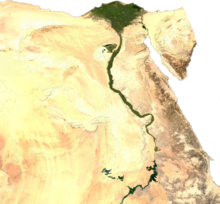
The piped water supply in Egypt increased between 1990 and 2010 from 89% to 100% in urban areas and from 39% to 93% in rural areas despite rapid population growth. Over that period, Egypt achieved the elimination of open defecation in rural areas and invested in infrastructure. Access to an improved water source in Egypt is now practically universal with a rate of 99%. About one half of the population is connected to sanitary sewers.[246]
Partly because of low sanitation coverage about 17,000 children die each year because of diarrhoea.[247] Another challenge is low cost recovery due to water tariffs that are among the lowest in the world. This in turn requires government subsidies even for operating costs, a situation that has been aggravated by salary increases without tariff increases after the Arab Spring. Poor operation of facilities, such as water and wastewater treatment plants, as well as limited government accountability and transparency, are also issues.
Due to the absence of appreciable rainfall, Egypt's agriculture depends entirely on irrigation. The main source of irrigation water is the river Nile of which the flow is controlled by the high dam at Aswan. It releases, on average, 55 cubic kilometres (45,000,000 acre·ft) water per year, of which some 46 cubic kilometres (37,000,000 acre·ft) are diverted into the irrigation canals.[248]
In the Nile valley and delta, almost 33,600 square kilometres (13,000 sq mi) of land benefit from these irrigation waters producing on average 1.8 crops per year.[248]
Demographics[değiştir | kaynağı değiştir]

Egypt is the most populated country in the Arab world and the third most populous on the African continent, with about 95 million inhabitants (2017 itibarıyla).[249] Its population grew rapidly from 1970 to 2010 due to medical advances and increases in agricultural productivity[250] enabled by the Green Revolution.[251] Egypt's population was estimated at 3 million when Napoleon invaded the country in 1798.[252]
Egypt's people are highly urbanised, being concentrated along the Nile (notably Cairo and Alexandria), in the Delta and near the Suez Canal. Egyptians are divided demographically into those who live in the major urban centres and the fellahin, or farmers, that reside in rural villages. The total inhabited area constitutes only 77,041 km², putting the physiological density at over 1,200 people per km2, similar to Bangladesh.
While emigration was restricted under Nasser, thousands of Egyptian professionals were dispatched abroad in the context of the Arab Cold War.[253] Egyptian emigration was liberalised in 1971, under President Sadat, reaching record numbers after the 1973 oil crisis.[254] An estimated 2.7 million Egyptians live abroad. Approximately 70% of Egyptian migrants live in Arab countries (923,600 in Saudi Arabia, 332,600 in Libya, 226,850 in Jordan, 190,550 in Kuwait with the rest elsewhere in the region) and the remaining 30% reside mostly in Europe and North America (318,000 in the United States, 110,000 in Canada and 90,000 in Italy).[234] The process of emigrating to non-Arab states has been ongoing since the 1950s.[255]
Ethnic groups[değiştir | kaynağı değiştir]
Ethnic Egyptians are by far the largest ethnic group in the country, constituting 99.7% of the total population.[67] Ethnic minorities include the Abazas, Turks, Greeks, Bedouin Arab tribes living in the eastern deserts and the Sinai Peninsula, the Berber-speaking Siwis (Amazigh) of the Siwa Oasis, and the Nubian communities clustered along the Nile. There are also tribal Beja communities concentrated in the southeasternmost corner of the country, and a number of Dom clans mostly in the Nile Delta and Faiyum who are progressively becoming assimilated as urbanisation increases.
Some 5 million immigrants live in Egypt, mostly Sudanese, "some of whom have lived in Egypt for generations".[256] Smaller numbers of immigrants come from Iraq, Ethiopia, Somalia, South Sudan, and Eritrea.[256]
The Office of the United Nations High Commissioner for Refugees estimated that the total number of "people of concern" (refugees, asylum seekers, and stateless people) was about 250,000. In 2015, the number of registered Syrian refugees in Egypt was 117,000, a decrease from the previous year.[256] Egyptian government claims that a half-million Syrian refugees live in Egypt are thought to be exaggerated.[256] There are 28,000 registered Sudanese refugees in Egypt.[256]
Jewish communities in Egypt have almost disappeared. Several important Jewish archaeological and historical sites are found in Cairo, Alexandria and other cities.
Languages[değiştir | kaynağı değiştir]
The official language of the Republic is Literary Arabic.[257] The spoken languages are: Egyptian Arabic (68%), Sa'idi Arabic (29%), Eastern Egyptian Bedawi Arabic (1.6%), Sudanese Arabic (0.6%), Domari (0.3%), Nobiin (0.3%), Beja (0.1%), Siwi and others.[kaynak belirtilmeli] Additionally, Greek, Armenian and Italian, and more recently, African languages like Amharic and Tigrigna are the main languages of immigrants.
The main foreign languages taught in schools, by order of popularity, are English, French, German and Italian.
Historically Egyptian was spoken, the latest stage of which is Coptic Egyptian. Spoken Coptic was mostly extinct by the 17th century but may have survived in isolated pockets in Upper Egypt as late as the 19th century. It remains in use as the liturgical language of the Coptic Orthodox Church of Alexandria.[258][259] It forms a separate branch among the family of Afroasiatic languages.
Religion[değiştir | kaynağı değiştir]
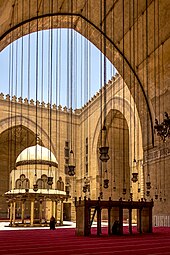
Egypt has the largest Muslim population in the Arab world, and the sixth world's largest Muslim population, and home for (5%) of the world's Muslim population.[260] Egypt also has the largest Christian population in the Middle East and North Africa.[261]
Egypt is a predominantly Sunni Muslim country with Islam as its state religion. The percentage of adherents of various religions is a controversial topic in Egypt. An estimated 85–90% are identified as Muslim, 10–15% as Coptic Christians, and 1% as other Christian denominations, although without a census the numbers cannot be known. Other estimates put the Christian population as high as 15–20%.[c] Non-denominational Muslims form roughly 12% of the population.[268][269]
Egypt was a Christian country before the 7th century, and after Islam arrived, the country was gradually Islamised into a majority-Muslim country.[270][271] It is not known when Muslims reached a majority variously estimated from y. 1000 CE to as late as the 14th century. Egypt emerged as a centre of politics and culture in the Muslim world. Under Anwar Sadat, Islam became the official state religion and Sharia the main source of law.[272] It is estimated that 15 million Egyptians follow Native Sufi orders,[273][274] with the Sufi leadership asserting that the numbers are much greater as many Egyptian Sufis are not officially registered with a Sufi order.[273] At least 305 people were killed during a November 2017 attack on a Sufi mosque in Sinai.[275]
There is also a Shi'a minority. The Jerusalem Center for Public Affairs estimates the Shia population at 1 to 2.2 million[276] and could measure as much as 3 million.[277] The Ahmadiyya population is estimated at less than 50,000,[278] whereas the Salafi (ultra-conservative Sunni) population is estimated at five to six million.[279] Cairo is famous for its numerous mosque minarets and has been dubbed "The City of 1,000 Minarets".[280]
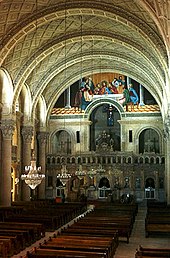
Of the Christian population in Egypt over 90% belong to the native Coptic Orthodox Church of Alexandria, an Oriental Orthodox Christian Church.[281] Other native Egyptian Christians are adherents of the Coptic Catholic Church, the Evangelical Church of Egypt and various other Protestant denominations. Non-native Christian communities are largely found in the urban regions of Cairo and Alexandria, such as the Syro-Lebanese, who belong to Greek Catholic, Greek Orthodox, and Maronite Catholic denominations.[282]
Egypt hosts the Coptic Orthodox Church of Alexandria. It was founded back in the first century, considered to be the largest church in the country.
Egypt is also the home of Al-Azhar University (founded in 969 CE, began teaching in 975 CE), which is today the world's "most influential voice of establishment Sunni Islam" and is, by some measures, the second-oldest continuously operating university in the world.[283]
Egypt recognises only three religions: Islam, Christianity, and Judaism. Other faiths and minority Muslim sects practised by Egyptians, such as the small Baháʼí Faith and Ahmadiyya communities, are not recognised by the state and face persecution by the government, which labels these groups a threat to Egypt's national security.[284][285] Individuals, particularly Baháʼís and atheists, wishing to include their religion (or lack thereof) on their mandatory state issued identification cards are denied this ability (see Egyptian identification card controversy), and are put in the position of either not obtaining required identification or lying about their faith. A 2008 court ruling allowed members of unrecognised faiths to obtain identification and leave the religion field blank.[203][204]
Education[değiştir | kaynağı değiştir]
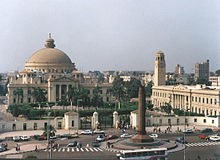
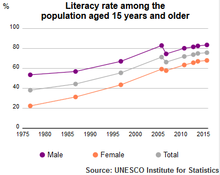
The illiteracy rate has decreased since 1996 from 39.4 to 25.9 percent in 2013. The adult literacy rate (2014 itibarıyla) was estimated at 73.9%.[286] The illiteracy rate is highest among those over 60 years of age being estimated at 64.9%, while illiteracy among youth between 15 and 24 years of age was listed at 8.6 percent.[287]
A European-style education system was first introduced in Egypt by the Ottomans in the early 19th century to nurture a class of loyal bureaucrats and army officers.[288] Under British occupation investment in education was curbed drastically, and secular public schools, which had previously been free, began to charge fees.[288]
In the 1950s, President Nasser phased in free education for all Egyptians.[288] The Egyptian curriculum influenced other Arab education systems, which often employed Egyptian-trained teachers.[288] Demand soon outstripped the level of available state resources, causing the quality of public education to deteriorate.[288] Today this trend has culminated in poor teacher–student ratios (often around one to fifty) and persistent gender inequality.[288]
Basic education, which includes six years of primary and three years of preparatory school, is a right for Egyptian children from the age of six.[289] After grade 9, students are tracked into one of two strands of secondary education: general or technical schools. General secondary education prepares students for further education, and graduates of this track normally join higher education institutes based on the results of the Thanaweya Amma, the leaving exam.[289]
Technical secondary education has two strands, one lasting three years and a more advanced education lasting five. Graduates of these schools may have access to higher education based on their results on the final exam, but this is generally uncommon.[289]
Cairo University is Egypt's premier public university. The country is currently opening new research institutes for the aim of modernising research in the nation, the most recent example of which is Zewail City of Science and Technology. Egypt was ranked 86th in the Global Innovation Index in 2023, up from 92nd in 2019.[290][291]
Health[değiştir | kaynağı değiştir]

Egyptian life expectancy at birth was 73.20 years in 2011, or 71.30 years for males and 75.20 years for females. Egypt spends 3.7 percent of its gross domestic product on health including treatment costs 22 percent incurred by citizens and the rest by the state.[292] In 2010, spending on healthcare accounted for 4.66% of the country's GDP. In 2009, there were 16.04 physicians and 33.80 nurses per 10,000 inhabitants.[293]
As a result of modernisation efforts over the years, Egypt's healthcare system has made great strides forward. Access to healthcare in both urban and rural areas greatly improved and immunisation programmes are now able to cover 98% of the population. Life expectancy increased from 44.8 years during the 1960s to 72.12 years in 2009. There was a noticeable decline of the infant mortality rate (during the 1970s to the 1980s the infant mortality rate was 101–132/1000 live births, in 2000 the rate was 50–60/1000, and in 2008 it was 28–30/1000).[294]
According to the World Health Organization in 2008, an estimated 91.1% of Egypt's girls and women aged 15 to 49 have been subjected to genital mutilation,[295] despite being illegal in the country. In 2016 the law was amended to impose tougher penalties on those convicted of performing the procedure, pegging the highest jail term at 15 years. Those who escort victims to the procedure can also face jail terms up to 3 years.[296]
The total number of Egyptians with health insurance reached 37 million in 2009, of which 11 million are minors, providing an insurance coverage of approximately 52 percent of Egypt's population.[297]
Largest cities[değiştir | kaynağı değiştir]
Culture[değiştir | kaynağı değiştir]
Egypt is a recognised cultural trendsetter of the Arabic-speaking world. Contemporary Arabic and Middle-Eastern culture is heavily influenced by Egyptian literature, music, film and television. Egypt gained a regional leadership role during the 1950s and 1960s, giving a further enduring boost to the standing of Egyptian culture in the Arabic-speaking world.[298]
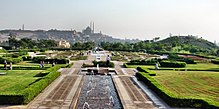
Egyptian identity evolved in the span of a long period of occupation to accommodate Islam, Christianity and Judaism; and a new language, Arabic, and its spoken descendant, Egyptian Arabic which is also based on many Ancient Egyptian words.[299]
The work of early 19th century scholar Rifa'a al-Tahtawi renewed interest in Egyptian antiquity and exposed Egyptian society to Enlightenment principles. Tahtawi co-founded with education reformer Ali Mubarak a native Egyptology school that looked for inspiration to medieval Egyptian scholars, such as Suyuti and Maqrizi, who themselves studied the history, language and antiquities of Egypt.[300]
Egypt's renaissance peaked in the late 19th and early 20th centuries through the work of people like Muhammad Abduh, Ahmed Lutfi el-Sayed, Muhammad Loutfi Goumah, Tawfiq el-Hakim, Louis Awad, Qasim Amin, Salama Moussa, Taha Hussein and Mahmoud Mokhtar. They forged a liberal path for Egypt expressed as a commitment to personal freedom, secularism and faith in science to bring progress.[301]
Arts[değiştir | kaynağı değiştir]

The Egyptians were one of the first major civilisations to codify design elements in art and architecture. Egyptian blue, also known as calcium copper silicate, is a pigment used by Egyptians for thousands of years. It is considered to be the first synthetic pigment. The wall paintings done in the service of the Pharaohs followed a rigid code of visual rules and meanings. Egyptian civilisation is renowned for its colossal pyramids, temples and monumental tombs.
Well-known examples are the Pyramid of Djoser designed by ancient architect and engineer Imhotep, the Sphinx, and the temple of Abu Simbel. Modern and contemporary Egyptian art can be as diverse as any works in the world art scene, from the vernacular architecture of Hassan Fathy and Ramses Wissa Wassef, to Mahmoud Mokhtar's sculptures, to the distinctive Coptic iconography of Isaac Fanous. The Cairo Opera House serves as the main performing arts venue in the Egyptian capital.
Literature[değiştir | kaynağı değiştir]

Egyptian literature traces its beginnings to ancient Egypt and is some of the earliest known literature. Indeed, the Egyptians were the first culture to develop literature as we know it today, that is, the book.[302] It is an important cultural element in the life of Egypt. Egyptian novelists and poets were among the first to experiment with modern styles of Arabic literature, and the forms they developed have been widely imitated throughout the Arab world.[303] The first modern Egyptian novel Zaynab by Muhammad Husayn Haykal was published in 1913 in the Egyptian vernacular.[304] Egyptian novelist Naguib Mahfouz was the first Arabic-language writer to win the Nobel Prize in Literature. Egyptian women writers include Nawal El Saadawi, well known for her feminist activism, and Alifa Rifaat who also writes about women and tradition.
Vernacular poetry is perhaps the most popular literary genre among Egyptians, represented by the works of Ahmed Fouad Negm (Fagumi), Salah Jaheen and Abdel Rahman el-Abnudi.[305]
Media[değiştir | kaynağı değiştir]
Egyptian media are highly influential throughout the Arab World, attributed to large audiences and increasing freedom from government control.[306][307] Freedom of the media is guaranteed in the constitution; however, many laws still restrict this right.[306][308]
Cinema[değiştir | kaynağı değiştir]
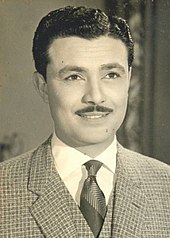

Egyptian cinema became a regional force with the coming of sound. In 1936, Studio Misr, financed by industrialist Talaat Harb, emerged as the leading Egyptian studio, a role the company retained for three decades.[309] For over 100 years, more than 4000 films have been produced in Egypt, three quarters of the total Arab production.[310][311] Egypt is considered the leading country in the field of cinema in the Arab world.[312] Actors from all over the Arab world seek to appear in the Egyptian cinema for the sake of fame. The Cairo International Film Festival has been rated as one of 11 festivals with a top class rating worldwide by the International Federation of Film Producers' Associations.[313]
The number of cinemas increased with the emergence of talking films, and reached 395 in 1958. This number began to decline after the establishment of television in 1960 and the establishment of the public sector in cinemas in 1962, and reached 297 in 1965, then to 141 in 1995 due to the circulation of films through video equipment though the boom of the film industry in this period. Due to laws and procedures that encouraged investment in the establishment of private cinemas, they increased again, especially in commercial centres, until their number reached 200 in 2001 and 400 in 2009. Over a period of more than a hundred years, Egyptian cinema has presented more than four thousand films.[314][315]
Music[değiştir | kaynağı değiştir]

Egyptian music is a rich mixture of indigenous, Mediterranean, African and Western elements. It has been an integral part of Egyptian culture since antiquity. The ancient Egyptians credited one of their gods Hathor with the invention of music, which Osiris in turn used as part of his effort to civilise the world. Egyptians used music instruments since then.[316]
Contemporary Egyptian music traces its beginnings to the creative work of people such as Abdu al-Hamuli, Almaz and Mahmoud Osman, who influenced the later work of Sayed Darwish, Umm Kulthum, Mohammed Abdel Wahab and Abdel Halim Hafez. Prominent contemporary Egyptian pop singers include Amr Diab and Mohamed Mounir.
Dances[değiştir | kaynağı değiştir]

Today, Egypt is often considered the home of belly dance. Egyptian belly dance has two main styles – raqs baladi and raqs sharqi. There are also numerous folkloric and character dances that may be part of an Egyptian-style belly dancer's repertoire, as well as the modern shaabi street dance which shares some elements with raqs baladi.
Museums[değiştir | kaynağı değiştir]
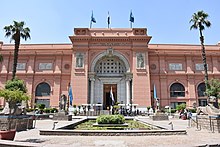
Egypt has one of the oldest civilisations in the world. It has been in contact with many other civilisations and nations and has been through so many eras, starting from prehistoric age to the modern age, passing through so many ages such as Pharonic, Roman, Greek, Islamic and many other ages. At least 60 museums may be found in Egypt.
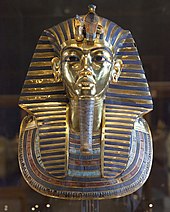
The three main museums in Egypt are The Egyptian Museum which has more than 120,000 items, the Egyptian National Military Museum and the 6th of October Panorama.
The Grand Egyptian Museum (GEM), also known as the Giza Museum, is an under construction museum that will house the largest collection of ancient Egyptian artifacts in the world, it has been described as the world's largest archaeological museum.[317] The museum was scheduled to open in 2015 and will be sited on 50 hektar (120 akre) of land approximately iki kilometre (1,2 mil) from the Giza Necropolis and is part of a new master plan for the plateau. The Minister of Antiquities Mamdouh al-Damaty announced in May 2015 that the museum will be partially opened in May 2018.[318]
Festivals[değiştir | kaynağı değiştir]
Egypt celebrates many festivals and religious carnivals, also known as mulid. They are usually associated with a particular Coptic or Sufi saint, but are often celebrated by Egyptians irrespective of creed or religion.
The ancient spring festival of Sham en Nisim (Coptic: Şablon:Coptic shom en nisim) has been celebrated by Egyptians for thousands of years, typically between the Egyptian months of Paremoude (April) and Pashons (May), following Easter Sunday.
Cuisine[değiştir | kaynağı değiştir]

Mısır mutfağı, ağırlıklı olarak sebze ve baklagil yemeklerine dayandığı için vejetaryen beslenmeye özellikle elverişlidir. İskenderiye ve Mısır kıyılarındaki diğer bölgelere ait yiyeceklerde çok miktarda balık ve diğer deniz ürünleri kullanılmasına rağmen Mısır mutfağı çoğunlukla toprakta yetişen yiyeceklere dayanmaktadır. Etin tarih boyunca Mısırlıların çoğu için çok pahalı olması sebebiyle nedenle çok sayıda vejetaryen yemek geliştirilmiştir. Bazı tatlılar ve ekmek benzeri besinler dışında mutfakta yağ oranı düşüktür. Genellikle sıcak iklimlerde enerji açısından yoğun gıdalar daha serin aylar için saklanmaktadır.
Some consider kushari (a mixture of rice, lentils, and macaroni) to be the national dish. In addition, ful medames (mashed fava beans) is one of the most popular dishes. Fava bean is also used in making falafel (also known as "ta'miya"), which may have originated in Egypt and spread to other parts of the Middle East. Garlic fried with coriander is added to molokhiya, a popular green soup made from finely chopped jute leaves, sometimes with chicken or rabbit.
Sports[değiştir | kaynağı değiştir]

Football is the most popular national sport of Egypt. The Cairo Derby is one of the fiercest derbies in Africa, and the BBC picked it as one of the 7 toughest derbies in the world.[319] Al Ahly is the most successful club of the 20th century in the African continent according to CAF, closely followed by their rivals Zamalek SC. They are known as the "African Club of the Century". With twenty titles, Al Ahly is currently the world's most successful club in terms of international trophies, surpassing Italy's A.C. Milan and Argentina's Boca Juniors, both having eighteen.[320]
The Egyptian national football team, known as the Pharaohs, won the African Cup of Nations seven times, including three times in a row in 2006, 2008, and 2010. Considered the most successful African national team and one which has reached the top 10 of the FIFA world rankings, Egypt has qualified for the FIFA World Cup three times. Two goals from star player Mohamed Salah in their last qualifying game took Egypt through to the 2018 FIFA World Cup.[321] The Egyptian Youth National team Young Pharaohs won the Bronze Medal of the 2001 FIFA youth world cup in Argentina. Egypt was 4th place in the football tournament in the 1928 and the 1964 Olympics.
Squash and tennis are other popular sports in Egypt. The Egyptian squash team has been competitive in international championships since the 1930s. Amr Shabana, Ali Farag and Ramy Ashour are Egypt's best players and all were ranked the world's number one squash player. Egypt has won the Squash World Championships five times, with the last title being in 2019.
In 1999, Egypt hosted the IHF World Men's Handball Championship, and hosted it again in 2021. In 2001, the national handball team achieved its best result in the tournament by reaching fourth place. Egypt has won in the African Men's Handball Championship five times, being the best team in Africa. In addition to that, it also championed the Mediterranean Games in 2013, the Beach Handball World Championships in 2004 and the Summer Youth Olympics in 2010. Among all African nations, the Egypt national basketball team holds the record for best performance at the Basketball World Cup and at the Summer Olympics.[322][323] Further, the team has won a record number of 16 medals at the African Championship.
Egypt has taken part in the Summer Olympic Games since 1912 and has hosted several other international competitions including the first Mediterranean Games in 1951, the 1991 All-Africa Games, the 2009 FIFA U-20 World Cup and the 1953, 1965 and 2007 editions of the Pan Arab Games.
Egypt featured a national team in beach volleyball that competed at the 2018–2020 CAVB Beach Volleyball Continental Cup in both the women's and the men's section.[324]
See also[değiştir | kaynağı değiştir]
Notes[değiştir | kaynağı değiştir]
- ^ Edebi Arapça ülkedeki tek resmî dildir.[1] Mısır Arapçası ise konuşulan dildir. Diğer lehçeler ve azınlık dilleri bölgesel olarak konuşulmaktadır
- ^ Ülkenin resmî dini çoğunluğun mensup olduğu İslam olsa da, ülkedeki Hristiyan azınlığın büyüklüğü oldukça tartışmalı bir konudur ve çeşitli kurum ve gruplar tarafından farklı görüşler öne sürülmektedir. Tahminler %5'ten başlayıp %20'e kadar yükselebilmektedir. 2006 yılından bu yana rakamların çarpıtıldığı yönündeki yaygın iddiaların ardından din nüfus sayımlarından çıkarılmıştır.[2][3][4].
- ^ The population of Egypt is estimated as being 90% Muslim, 9% Coptic Christian and 1% other Christian, though estimates vary.[262][263][264] Microsoft Encarta Online similarly estimates the Sunni population at 90% of the total.[265] The Pew Forum on Religion and Public Life gave a higher estimate of the Muslim population, at 94.6%.[266] In 2017, the government-owned newspaper Al Ahram estimated the percentage of Christians at 10 to 15%.[267]
References[değiştir | kaynağı değiştir]
- ^ "Constitutional Declaration: A New Stage in the History of the Great Egyptian People". Egypt State Information Service. 30 March 2011. 27 April 2011 tarihinde kaynağından arşivlendi. Erişim tarihi: 9 Nisan 2024.
- ^ "How many Christians are there in Egypt?". Pew Research Center. 16 February 2011. Erişim tarihi: 19 March 2018.
- ^ "Egypt's Sisi meets world Evangelical churches delegation in Cairo". english.ahram.org.eg. Erişim tarihi: 10 April 2024.
- ^ "Egyptian Copts reject population estimate – Politics". english.ahram.org.eg. Erişim tarihi: 10 April 2024.
- ^ Truex, Rory; Tavana, Daniel L. (July 2019). "Implicit Attitudes toward an Authoritarian Regime". The Journal of Politics. 81 (3): 1014–1027. doi:10.1086/703209.
- ^ Cambanis, Thanassis (22 May 2015). "Egypt's Sisi Is Getting Pretty Good … at Being a Dictator". Foreign Policy. Erişim tarihi: 9 Nisan 2024.
- ^ "Egypt: A Move to Enhance Authoritarian Rule". Human Rights Watch. 2019.
- ^ Raghavan, Sudarsan (9 July 2020). "Egypt tries to silence its critics in the United States by jailing their relatives". The Washington Post. Erişim tarihi: 9 Nisan 2024.
- ^ Al-Arian, Abdullah (27 February 2020). "Hosni Mubarak's legacy is Abdel Fattah el-Sisi". Al Jazeera (İngilizce). 19 October 2020 tarihinde kaynağından arşivlendi. Erişim tarihi: 9 Nisan 2024.
- ^ Goldschmidt, Arthur (1988). Modern Egypt: The Formation of a Nation-State. Boulder, CO: Westview Press. s. 5. ISBN 978-0-86531-182-4. 17 December 2020 tarihinde kaynağından arşivlendi. Erişim tarihi: 9 Nisan 2024.
Among the peoples of the ancient Near East, only the Egyptians have stayed where they were and remained what they were, although they have changed their language once and their religion twice. In a sense, they constitute the world's oldest nation. For most of their history, Egypt has been a state, but only in recent years has it been truly a nation-state, with a government claiming the allegiance of its subjects on the basis of a common identity.
- ^ "Background Note: Egypt". United States Department of State Bureau of Near Eastern Affairs. 10 November 2010. Erişim tarihi: 9 Nisan 2024.
- ^ Pierre Crabitès (1935). Ibrahim of Egypt. Routledge. s. 1. ISBN 978-0-415-81121-7. 9 May 2013 tarihinde kaynağından arşivlendi. Erişim tarihi: 9 Nisan 2024.
... on July 9, 1805, Constantinople conferred upon Muhammad Ali the pashalik of Cairo ...
- ^ "Density By Governorate 1/7/2020 – Area km2 (Theme: Population – pg.14)". Capmas.gov.eg. Erişim tarihi: 9 Nisan 2024.
- ^ "Total area km2, pg.15" (PDF). Capmas.Gov – Arab Republic of Egypt. 21 March 2015 tarihinde kaynağından (PDF) arşivlendi. Erişim tarihi: 9 Nisan 2024.
- ^ "The World Factbook". The World Factbook (2024 bas.). CIA. Erişim tarihi: 9 Nisan 2024.
- ^ a b c d "World Economic Outlook Database, October 2023 Edition. (Egypt)". IMF.org. International Monetary Fund. 10 October 2023. Erişim tarihi: 9 Nisan 2024.
- ^ "GINI index (World Bank estimate)". World Bank. Erişim tarihi: 30 March 2020.
- ^ "Gini Index coefficient - distribution of family income - The World Factbook". www.cia.gov. Erişim tarihi: 2022-08-24.
- ^ "Human Development Report 2021/2022" (PDF) (İngilizce). United Nations Development Programme. 8 September 2022. Erişim tarihi: 9 Nisan 2024.
- ^ Midant-Reynes, Béatrix. The Prehistory of Egypt: From the First Egyptians to the First Kings. Oxford: Blackwell Publishers.
- ^ "Constitution of The Arab Republic of Egypt 2014" (PDF). sis.gov.eg. 18 July 2015 tarihinde kaynağından (PDF) arşivlendi. Erişim tarihi: 9 Nisan 2024.
- ^ "Urban population (% of total population) - Egypt, Arab Rep". World Bank. Erişim tarihi: 9 Nisan 2024.
- ^ "Lessons from/for BRICSAM about south–north Relations at the Start of the 21st Century: Economic Size Trumps All Else?". International Studies Review. 9.
- ^ "Arab Republic of Egypt and the IMF". IMF (İngilizce). Erişim tarihi: 9 Nisan 2024.
- ^ "mısır". Nişanyan Sözlük. Erişim tarihi: 2024-04-10.
- ^ Z., T. (1928). "Il-Belt (Valletta)" (PDF). Il-Malti (Maltaca) (2 bas.). Il-Ghaqda tal-Kittieba tal-Malti. 2 (1): 35. 17 April 2016 tarihinde kaynağından (PDF) arşivlendi.
- ^ "مصرايم". St-Takla.org. Erişim tarihi: 2024-04-10.
- ^ Izre', Shlomo. "On the So-Called Ventive Morpheme in the Akkadian Texts of Amurru". www.academia.edu: 84. 18 January 2016 tarihinde kaynağından arşivlendi. Erişim tarihi: 10 April 2024.
- ^ Black, Jeremy A.; George, Andrew; Postgate, J.N. (2000). A Concise Dictionary of Akkadian. Otto Harrassowitz Verlag. ISBN 978-3-447-04264-2.
- ^ "RINAP 5/1 Ashurbanipal 011, ex. 001 (P421807)". CDLI (İngilizce). Erişim tarihi: 2024-04-10.
- ^ Breyer, Fr. A. K. "Morgenländische Wörter im Deutschen: Die ägyptischen Lehnwörter". In: W. Raunig/St. Wenig. Afrikas Horn: Akten der Ersten Internatio-nalen Littmann-Konferenz 2. bis 5. Mai 2002 in München. Meroitica 22. Wiesbaden: Otto Harrassowitz Verlag, 2005. s. 381. 9783447051750.
- ^ Rosalie, David (1997). Pyramid Builders of Ancient Egypt: A Modern Investigation of Pharaoh's Workforce. Routledge. s. 18.
- ^ Muḥammad Jamāl al-Dīn Mukhtār (1990). Ancient Civilizations of Africa. Currey. s. 43. ISBN 978-0-85255-092-2. 31 January 2017 tarihinde kaynağından arşivlendi. Erişim tarihi: 12 Nisan 2024.
- ^ Antonio Loprieno, "Egyptian and Coptic Phonology", in Phonologies of Asia and Africa (including the Caucasus). Vol 1 of 2. Ed: Alan S Kaye. Winona Lake, Indiana: Eisenbrauns, 1997: s. 449
- ^ "Henry George Liddell, Robert Scott, A Greek-English Lexicon, Χ χ, χεσι^φωνέω, Χημία". www.perseus.tufts.edu. Erişim tarihi: 12 Nisan 2024.
- ^ "A Brief History of Alchemy". University of Bristol School of Chemistry. 5 October 2008 tarihinde kaynağından arşivlendi. Erişim tarihi: 12 Nisan 2024.
- ^ Breasted, James Henry; Peter A. Piccione (2001). Ancient Records of Egypt. University of Illinois Press. ss. 76, 40. ISBN 978-0-252-06975-8.
- ^ Midant-Reynes, Béatrix. The Prehistory of Egypt: From the First Egyptians to the First Kings. Oxford: Blackwell Publishers.
- ^ "The Nile Valley 6000–4000 BCE Neolithic". The British Museum. 2005. 14 February 2009 tarihinde kaynağından arşivlendi. Erişim tarihi: 12 Nisan 2024.
- ^ Shaw, Ian, (Ed.) (2003). The Oxford History of Ancient Egypt. Oxford: Oxford University Press. s. 69. ISBN 0-19-280458-8.
- ^ "The Fall of the Egyptian Old Kingdom". BBC. 17 February 2011. 17 November 2011 tarihinde kaynağından arşivlendi. Erişim tarihi: 12 Nisan 2024.
- ^ "The Kushite Conquest of Egypt". Ancientsudan.org. 1 February 2011 tarihinde kaynağından arşivlendi. Erişim tarihi: 12 Nisan 2024.
- ^ Shaw, Ian, (Ed.) (2003). The Oxford History of Ancient Egypt. Oxford: Oxford University Press. s. 383. ISBN 0-19-280458-8.
- ^ Jones, Prudence J. (2006). Cleopatra: A Sourcebook. Norman: University of Oklahoma Press. s. 14. ISBN 978-0806137414.
They were members of the Ptolemaic dynasty of Macedonian Greeks, who ruled Egypt after the death of its conqueror, Alexander the Great. [Onlar, Mısır'ı fetheden Büyük İskender'in ölümünden sonra (Mısır'ı) yöneten Makedon Yunanların Ptolemaios Hanedanı'nın üyeleriydi.]
Geçersiz|url-erişimi=registration(yardım) - ^ Bowman, Alan K (1996). Egypt after the Pharaohs 332 BC – AD 642 (2nd bas.). Berkeley: University of California Press. ss. 25–26. ISBN 0-520-20531-6.
- ^ Stanwick, Paul Edmond (2003). Portraits of the Ptolemies: Greek kings as Egyptian pharaohs. Austin: University of Texas Press. ISBN 0-292-77772-8.
- ^ a b "Egypt". Berkley Center for Religion, Peace, and World Affairs. 20 Aralık 2011 tarihinde kaynağından arşivlendi. Erişim tarihi: 27 Nisan 2024.
- ^ Kamil, Jill. Coptic Egypt: History and Guide. Cairo: American University in Cairo, 1997. s. 39
- ^ a b c Abu-Lughod, Janet L. (1991) [1989]. "The Mideast Heartland". Before European Hegemony: The World System A.D. 1250–1350. New York: Oxford University Press. ss. 243–244. ISBN 978-0-19-506774-3.
- ^ "Egypt – Major Cities". Countrystudies.us. 17 Ocak 2013 tarihinde kaynağından arşivlendi. Erişim tarihi: 27 Nisan 2024.
- ^ Bilinmeyen Osmanlı, Ahmet Akgündüz ve Sait Öztürk, OSAV Yayınları, 1999
- ^ Donald Quataert (2005). The Ottoman Empire, 1700–1922. Cambridge University Press. s. 115. ISBN 978-1-139-44591-7. 13 Şubat 2014 tarihinde kaynağından arşivlendi. Erişim tarihi: 27 Nisan 2024.
- ^ "Icelandic Volcano Caused Historic Famine In Egypt, Study Shows". ScienceDaily. 22 Kasım 2006. 17 Ocak 2013 tarihinde kaynağından arşivlendi. Erişim tarihi: 27 Nisan 2024.
- ^ Resimli Osmanlı Tarihi, Yavuz Bahadıroğlu, Nesil Yayınları
- ^ Izzeddin, Nejla M. Abu (1981). Nasser of the Arabs: an Arab assessment. Third World Centre for Research and Publishing. s. 2. ISBN 978-0-86199-012-2.
- ^ a b Baten, Jörg (2016). A History of the Global Economy. From 1500 to the Present. Cambridge University Press. s. 217. ISBN 978-1-107-50718-0.
- ^ Fahmy, Khaled (1997). All the Pasha's Men: Mehmed Ali, his army and the making of modern Egypt. Cambridge Middle East Studies. 8. Cambridge University Press. ss. 119–147. ISBN 978-0-521-56007-8.
- ^ Baten, Jörg (2016). A History of the Global Economy. From 1500 to the Present. Cambridge University Press. s. 220, Figure 7.4 "Numeracy in selected Middle Eastern countries", based on Prayon and Baten (2013). ISBN 978-1-107-50718-0.
- ^ Nejla M. Abu Izzeddin, Nasser of the Arabs, s. 2.
- ^ Baten, Jörg (2016). A History of the Global Economy. From 1500 to the Present. Cambridge University Press. ss. 217, 224 Figure 7.6: "Height development in the Middle East and the world (male)" and 225. ISBN 978-1-107-50718-0.
- ^ Anglo French motivation: Derek Hopwood, Egypt: Politics and Society 1945–1981. London, 1982, George Allen & Unwin. s. 11.
- ^ De facto protectorate: Joan Wucher King, Historical Dictionary of Egypt. Metuchen, NJ; 1984; Scarecrow. s. 17.
- ^ Jankowski, James. Egypt, A Short History. s. 111.
- ^ "Treaty of Lausanne – World War I Document Archive". wwi.lib.byu.edu. Erişim tarihi: 27 Nisan 2024.
- ^ Jankowski, James. Egypt, A Short History. s. 112.
- ^ Collins, Robert O.; Collins, Professor of History Robert O. (29 May 2008). A History of Modern Sudan (İngilizce). Cambridge University Press. ISBN 978-0-521-85820-5.
- ^ a b c "Egypt". The World Factbook. CIA. Erişim tarihi: 27 Nisan 2024.
- ^ "ذاكرة مصر المعاصر – السيرة الذاتية". modernegypt.bibalex.org. Erişim tarihi: 24 September 2018.
- ^ Orkaby, Asher Aviad. (2014). "The International History of the Yemen Civil War, 1962-1968" (PDF). Doctoral Dissertation, Harvard University.
- ^ Aburish, Said K. (2004). Nasser, the Last Arab. New York City: St. Martin's Press. s. 252. ISBN 978-0-312-28683-5.
- ^ Kandil, Hazem (2012). Soldiers, Spies and Statesmen: Egypt's Road to Revolt. Brooklyn: Verso Books. s. 76. ISBN 978-1-84467-962-1.
- ^ Shlaim, Rogan, 2012 pp. 7, 106
- ^ Samir A. Mutawi (2002). Jordan in the 1967 War. Cambridge University Press. s. 95. ISBN 978-0-521-52858-0. 6 September 2015 tarihinde kaynağından arşivlendi. Erişim tarihi: 20 June 2015.
- ^ "The Emergency Law in Egypt". International Federation for Human Rights. 1 February 2011 tarihinde kaynağından arşivlendi. Erişim tarihi: 2 February 2011.
- ^ "Egypt – Emergency Law No. 162/1958". www.ilo.org. Erişim tarihi: 2022-05-07.
- ^ a b Egypt on the Brink by Tarek Osman, Yale University Press, 2010, p. 120
- ^ Jesse Ferris (2013). Nasser's Gamble: How Intervention in Yemen Caused the Six-Day War and the Decline of Egyptian Power. Princeton University Press. s. 2. ISBN 978-0-691-15514-2. 6 September 2015 tarihinde kaynağından arşivlendi. Erişim tarihi: 20 June 2015.
- ^ Amin, Galal. Egypt's Economic Predicament: A Study in the Interaction of External Pressure, Political Folly, and Social Tension in Egypt, 1960–1990, 1995
- ^ Vatikiotis, P.J. (1991). The History of Modern Egypt: From Muhammad Ali to Mubarak (4. bas.). London: Weidenfeld and Nicolson. s. 443. ISBN 978-0-297-82034-5.
- ^ a b Cambanis, Thanassis (11 September 2010). "Succession Gives Army a Stiff Test in Egypt". The New York Times. Egypt. 27 October 2011 tarihinde kaynağından arşivlendi. Erişim tarihi: 3 November 2011.
- ^ Middle East International No 270, 7 March 1986, Publishers Lord Mayhew, Dennis Walters. Simon Ingram p. 8, Per Gahrton p.20
- ^ Murphy, Caryle Passion for Islam: Shaping the Modern Middle East: the Egyptian Experience, Scribner, 2002, p. 4
- ^ "Solidly ahead of oil, Suez Canal revenues, and remittances, tourism is Egypt's main hard currency earner at $6.5 billion per year." (in 2005) ... concerns over tourism's future 24 Eylül 2013[Tarih uyuşmuyor] tarihinde Wayback Machine sitesinde arşivlendi.. Retrieved 27 September 2007.
- ^ Kepel, Gilles (2002). Jihad: The Trail of Political Islam (İngilizce). Harvard University Press. s. [sayfa belirt]. ISBN 978-0-674-01090-1.
- ^ "Evaluating Egyptian REfoRm" (PDF). Carnegie P a P e R S.
- ^ Dunne, Michele (January 2006). "Evaluating Egyptian Reform". Carnegie Papers: Middle East Series (66): 4.
- ^ "Mubarak throws presidential race wide open". Business Today Egypt. 10 March 2005. 10 March 2005 tarihinde kaynağından arşivlendi. Erişim tarihi: 8 February 2013.
- ^ "Democracy on the Nile: The story of Ayman Nour and Egypt's problematic attempt at free elections". Weeklystandard.com. 27 March 2006. 7 January 2012 tarihinde kaynağından arşivlendi. Erişim tarihi: 3 November 2011.
- ^ Gomez, Edward M (12 September 2005). "Hosni Mubarak's pretend democratic election". San Francisco Chronicle. 15 September 2005 tarihinde kaynağından arşivlendi. Erişim tarihi: 8 February 2013.
- ^ "Egyptian vote marred by violence". Christian Science Monitor. 26 May 2005. 8 February 2013 tarihinde kaynağından arşivlendi. Erişim tarihi: 8 February 2013.
- ^ "United States "Deeply Troubled" by Sentencing of Egypt's Nour". U.S. Department of State. 24 December 2005. 21 October 2011 tarihinde kaynağından arşivlendi. Erişim tarihi: 8 February 2013.
- ^ a b "Egypt: Events of 2005". Egypt: Overview of human rights issues in Egypt. Human Rights Watch. 5 January 2006. 14 November 2008 tarihinde kaynağından arşivlendi. Erişim tarihi: 8 February 2013.
- ^ "Egypt torture centre, report says". BBC News. 11 April 2007. 26 November 2011 tarihinde kaynağından arşivlendi. Erişim tarihi: 3 November 2011.
- ^ "Egypt rejects torture criticism". BBC News. 13 April 2007. 31 March 2012 tarihinde kaynağından arşivlendi. Erişim tarihi: 3 November 2011.
- ^ "Anger over Egypt vote timetable". BBC News. 20 March 2007. 29 November 2011 tarihinde kaynağından arşivlendi. Erişim tarihi: 3 November 2011.
- ^ "Mubarak Resigns As Egypt's President, Armed Forces To Take Control". Huffington Post. 11 February 2011. 22 March 2013 tarihinde kaynağından arşivlendi. Erişim tarihi: 8 February 2013.
- ^ Kirkpatrick, David D. (11 February 2010). "Mubarak Steps Down, Ceding Power to Military". The New York Times. 11 February 2011 tarihinde kaynağından arşivlendi. Erişim tarihi: 11 February 2011.
- ^ "Egypt crisis: President Hosni Mubarak resigns as leader". BBC. 11 February 2010. 11 February 2011 tarihinde kaynağından arşivlendi. Erişim tarihi: 11 February 2011.
- ^ Hope, Christopher; Swinford, Steven (15 February 2011). "WikiLeaks: Egypt's new man at the top 'was against reform'". The Daily Telegraph. 10 March 2011 tarihinde kaynağından arşivlendi. Erişim tarihi: 5 March 2011.
- ^ "The Supreme Council of the Armed Forces: Constitutional Proclamation". Egypt State Information Service. 13 February 2011. 27 April 2011 tarihinde kaynağından arşivlendi. Erişim tarihi: 5 March 2011.
The Chairman of the Supreme Council of the Armed Forces shall represent it internally and externally.
- ^ "Egyptian Parliament dissolved, constitution suspended". BBC. 13 February 2011. 14 February 2011 tarihinde kaynağından arşivlendi. Erişim tarihi: 13 February 2011.
- ^ Harris, Marty. "The Egyptian constitutional referendum of March 2011 a new beginning". www.aph.gov.au (İngilizce).
- ^ Memmott, Mark (28 November 2011). "Egypt's Historic Day Proceeds Peacefully, Turnout High For Elections". NPR. Npr.org. 2 December 2012 tarihinde kaynağından arşivlendi. Erişim tarihi: 8 February 2013.
- ^ "Egypt's new president moves into his offices, begins choosing a Cabinet". CNN. 25 June 2012. 12 May 2013 tarihinde kaynağından arşivlendi. Erişim tarihi: 13 February 2013.
- ^ "Mohamed Morsi sworn in as Egypt's president". www.aljazeera.com (İngilizce).
- ^ "Egypt unveils new cabinet, Tantawi keeps defence post". 3 August 2012.
- ^ "Rallies for, against Egypt president's new powers". Associated Press. 23 November 2012. 29 November 2012 tarihinde kaynağından arşivlendi. Erişim tarihi: 23 November 2012.
- ^ "Egypt's President Mursi assumes sweeping powers". BBC News. 22 November 2012. 22 November 2012 tarihinde kaynağından arşivlendi. Erişim tarihi: 23 November 2012.
- ^ Spencer, Richard (23 November 2012). "Violence breaks out across Egypt as protesters decry Mohammed Morsi's constitutional 'coup'". The Daily Telegraph. London. 27 November 2012 tarihinde kaynağından arşivlendi. Erişim tarihi: 23 November 2012.
- ^ "Egypt Sees Largest Clash Since Revolution". Wall Street Journal. 6 December 2012. 21 April 2015 tarihinde kaynağından arşivlendi. Erişim tarihi: 8 December 2012.
- ^ Fleishman, Jeffrey (6 December 2012). "Morsi refuses to cancel Egypt's vote on constitution". Los Angeles Times. 8 December 2012 tarihinde kaynağından arşivlendi. Erişim tarihi: 8 December 2012.
- ^ a b "Think Again: The Muslim Brotherhood". Al-Monitor. 28 January 2013. 2 February 2017 tarihinde kaynağından arşivlendi. Erişim tarihi: 7 December 2016.
- ^ Kirkpatrick, David D. (3 July 2013). "Army Ousts Egypt's President; Morsi Denounces 'Military Coup'". The New York Times. 4 July 2013 tarihinde kaynağından arşivlendi. Erişim tarihi: 3 July 2013.
- ^ Holpuch, Amanda; Siddique, Haroon; Weaver, Matthew (4 July 2013). "Egypt's interim president sworn in - Thursday 4 July". The Guardian.
- ^ "Egypt protests: Hundreds killed after police storm pro-Morsi camps". ABC News. Australian Broadcasting Corporation. 15 August 2013. 4 August 2014 tarihinde kaynağından arşivlendi. Erişim tarihi: 29 July 2014.
- ^ "Abuse claims rife as Egypt admits jailing 16,000 Islamists in eight months". The Independent. 16 March 2014. 4 September 2014 tarihinde kaynağından arşivlendi. Erişim tarihi: 29 July 2014.
- ^ "Egypt sentences 683 to death in latest mass trial of dissidents". The Washington Post. 28 April 2014. 20 June 2014 tarihinde kaynağından arşivlendi. Erişim tarihi: 29 July 2014.
- ^ "Egyptian court sentences 529 people to death". The Washington Post. 24 March 2014. 5 August 2014 tarihinde kaynağından arşivlendi. Erişim tarihi: 29 July 2014.
- ^ "Egyptian court sentences Muslim Brotherhood leader to life in prison". Reuters. 4 July 2014. 29 July 2014 tarihinde kaynağından arşivlendi. Erişim tarihi: 29 July 2014.
- ^ "Egypt constitution 'approved by 98.1 percent'". Al Jazeera English. 18 January 2014. 19 January 2014 tarihinde kaynağından arşivlendi. Erişim tarihi: 18 January 2014.
- ^ "Egypt's new constitution gets 98% 'yes' vote". the Guardian (İngilizce). 2014-01-18. Erişim tarihi: 2022-11-25.
- ^ "Egypt's El-Sisi bids military farewell, says he will run for presidency". Ahram Online. 26 March 2014. 27 March 2014 tarihinde kaynağından arşivlendi. Erişim tarihi: 26 March 2014.
- ^ "Former army chief scores landslide victory in Egypt presidential polls". The Guardian. 29 May 2014 tarihinde kaynağından arşivlendi. Erişim tarihi: 29 May 2014.
- ^ "Sisi sworn in as Egypt's president". France 24 (İngilizce). 8 June 2014.
- ^ "Sisi elected Egypt president by landslide". 30 May 2014. 2 June 2014 tarihinde kaynağından arşivlendi. Erişim tarihi: 29 July 2014.
- ^ "Egypt election: Sisi secures landslide win". BBC. 29 May 2014. 22 July 2014 tarihinde kaynağından arşivlendi. Erişim tarihi: 29 July 2014.
- ^ "Egypt's elections committee announces final parliamentary results - Egypt Elections 2015 - Egypt". Ahram Online.
- ^ "Giulio Regeni murder: Italy recalls ambassador to Egypt". BBC News. 8 April 2016.
- ^ "Italy to return ambassador to Cairo, ending standoff over murdered student". Reuters (İngilizce). 14 August 2017.
- ^ "Egypt's Sisi wins 97 percent in election with no real opposition". Reuters (İngilizce). 2 April 2018.
- ^ "Egypt parliament extends presidential term to six years". www.aa.com.tr.
- ^ "Sisi wins snap Egyptian referendum amid vote-buying claims". the Guardian (İngilizce). 23 April 2019.
- ^ Walsh, Decian (9 February 2020). "For Thousands of Years, Egypt Controlled the Nile. A New Dam Threatens That". New York Times. 10 February 2020 tarihinde kaynağından arşivlendi.
- ^ "An Egyptian cyber attack on Ethiopia by hackers is the latest strike over the Grand Dam". Quartz. 27 June 2020.
- ^ "Are Egypt and Ethiopia heading for a water war?". The Week. 8 July 2020.
- ^ "Row over Africa's largest dam in danger of escalating, warn scientists". Nature. 15 July 2020.
- ^ "Pro-Sisi party wins majority in Egypt's parliamentary polls". Reuters (İngilizce). 14 December 2020.
- ^ Saafan, Farah; Lewis, Aidan (19 December 2023). "Egypt's Sisi sweeps to third term as president with 89.6% of vote". Reuters. Erişim tarihi: 3 March 2024.
- ^ "World Factbook area rank order". Cia.gov. 9 February 2014 tarihinde kaynağından arşivlendi. Erişim tarihi: 1 February 2011.
- ^ "Land use and Coastal Management in the Third Countries: Egypt as a case" (PDF). 24 March 2009 tarihinde kaynağından (PDF) arşivlendi. Erişim tarihi: 3 November 2011.
- ^ Fouberg, Erin H.; Murphy, Alexander B.; de Blij (2009). Human Geography: People, Place, and Culture. John Wiley & Sons. s. 91. ISBN 978-0-470-57647-2. 9 May 2013 tarihinde kaynağından arşivlendi. Erişim tarihi: 10 February 2013.
- ^ "Egypt to build new administrative and business capital". BBC News. 13 March 2015. 16 December 2018 tarihinde kaynağından arşivlendi. Erişim tarihi: 20 June 2018.
- ^ Soliman, KH. Rainfall over Egypt. Quarterly Journal of the Royal Meteorological Society, vol. 80, issue 343, p. 104.
- ^ "Marsa Matruh, Egypt". Weatherbase.com. 4 November 2011 tarihinde kaynağından arşivlendi. Erişim tarihi: 3 November 2011.
- ^ Samenow, Jason (13 December 2013). "Biblical snowstorm: Rare flakes in Cairo, Jerusalem paralyzed by over a foot". The Washington Post. 3 September 2015 tarihinde kaynağından arşivlendi. Erişim tarihi: 26 August 2017.
- ^ "Contingency planning for rising sea levels in Egypt | IRIN News, March 2008". Irinnews.org. 12 March 2008. 27 August 2010 tarihinde kaynağından arşivlendi. Erişim tarihi: 25 August 2010.
- ^ El Deeb and Keath, Sarah and Lee. "Islamist claims victory in Egypt president vote". Associated Press. 20 June 2012 tarihinde kaynağından arşivlendi. Erişim tarihi: 18 June 2012.
- ^ "List of Parties". 24 January 2011 tarihinde kaynağından arşivlendi. Erişim tarihi: 8 December 2012.
- ^ "Egypt: National Strategy and Action Plan for Biodiversity Conservation" (PDF). 17 January 2013 tarihinde kaynağından (PDF) arşivlendi. Erişim tarihi: 9 December 2012.
- ^ "The Micheli Guide to Fungal Conservation". 19 February 2015 tarihinde kaynağından arşivlendi. Erişim tarihi: 9 December 2012.
- ^ A.M. Abdel-Azeem, The History, Fungal Biodiversity, Conservation, and Future Perspectives for Mycology in Egypt IMA Fungus 1 (2): 123–142 (2010).
- ^ Ibrahim, Kamal M.; Hosni, Hasnaa A.; Peterson, Paul M. (2016). Grasses of Egypt. Washington, D.C.: Smithsonian Institution Scholarly Press. Erişim tarihi: 16 April 2016.
- ^ "Timetable for Egypt's parliamentary elections announced; voting to start 17 Oct". Ahram Online. 30 August 2015. 4 September 2015 tarihinde kaynağından arşivlendi. Erişim tarihi: 11 September 2015.
- ^ "Egypt to Hold Presidential Polls First: Interim President". Ahram Online. 26 January 2014. 7 April 2014 tarihinde kaynağından arşivlendi. Erişim tarihi: 2 April 2014.
- ^ "El-Sisi wins Egypt's presidential race with 96.91%". English.Ahram.org. Ahram Online. 31 July 2014 tarihinde kaynağından arşivlendi. Erişim tarihi: 28 July 2014.
- ^ "Who's Who: Members of Egypt's 50-member constitution committee". Al-Ahram. 3 September 2013 tarihinde kaynağından arşivlendi. Erişim tarihi: 1 September 2013.
- ^ "Egypt". Freedom in the World 2024. Freedom House. Erişim tarihi: 3 March 2024.
- ^ V-Dem Institute (2023). "The V-Dem Dataset". Erişim tarihi: 14 October 2023.
- ^ "Democracy Index 2023: Age of conflict" (PDF). Economist Intelligence Unit (İngilizce). 2024. s. 3.
- ^ Jankowski, James. "Egypt and Early Arab Nationalism" in Rashid Khalidi, ed. The Origins of Arab Nationalism. New York: Columbia University Press, 1990, pp. 244–45
- ^ Dawisha, Adeed (2003). Arab Nationalism in the Twentieth Century. Princeton: Princeton University Press. ss. 264–265, 267.
- ^ a b Brown, Nathan J. "Mechanisms of Accountability in Arab Governance: The Present and Future of Judiciaries and Parliaments in the Arab World". Programme on Governance in the Arab Region. 5 June 2012 tarihinde kaynağından arşivlendi.
- ^ Cambanis, Thanassis (11 September 2010). "Succession Gives Army a Stiff Test in Egypt". The New York Times. 3 May 2011 tarihinde kaynağından arşivlendi. Erişim tarihi: 11 September 2010.
- ^ Marshall, Shana (15 April 2015). "The Egyptian Armed Forces and the Remaking of an Economic Empire". Carnegie Endowment for International Peace. 9 July 2015 tarihinde kaynağından arşivlendi. Erişim tarihi: 23 June 2015.
- ^ Katz, Yaacov (15 January 2007). "Egypt to launch first spy satellite". The Jerusalem Post.
- ^ Stephen Clark (16 April 2014). "Egyptian reconnaissance satellite launched by Soyuz". Spaceflight Now. 19 April 2014 tarihinde kaynağından arşivlendi. Erişim tarihi: 18 April 2014.
- ^ "Obama restores US military aid to Egypt over Islamic State concerns". The Guardian. 31 March 2015. 14 December 2016 tarihinde kaynağından arşivlendi. Erişim tarihi: 14 December 2016.
- ^ "The U.S. gives Egypt $1.5 billion a year in aid. Here's what it does." The Washington Post. 9 July 2013. 15 July 2015 tarihinde kaynağından arşivlendi. Erişim tarihi: 26 August 2017.
- ^ Sharp, Jeremy M. (5 June 2014). "Egypt: Background and U.S. Relations" (PDF). Congressional Research Service. 9 September 2014 tarihinde kaynağından (PDF) arşivlendi. Erişim tarihi: 8 October 2014.
- ^ Holland, Steve; Mason, Jeff (15 August 2013). "Obama cancels military exercises, condemns violence in Egypt". Reuters. 14 October 2014 tarihinde kaynağından arşivlendi. Erişim tarihi: 8 October 2014.
- ^ Iqbal, Jawad (7 May 2015). "Business as usual for Egypt and the West". BBC. 1 August 2015 tarihinde kaynağından arşivlendi. Erişim tarihi: 23 June 2015.
- ^ "Egypt 'has key role' in fight against Islamic State – Kerry". BBC. 13 September 2014. 4 October 2014 tarihinde kaynağından arşivlendi. Erişim tarihi: 18 October 2014.
- ^ Adler, Stephen; Mably, Richard (15 May 2014). "Exclusive: Egypt's Sisi asks for U.S. help in fighting terrorism". Reuters. 23 October 2014 tarihinde kaynağından arşivlendi. Erişim tarihi: 18 October 2014.
- ^ Baker, Peter; Walsh, Declan (3 April 2017). "Trump Shifts Course on Egypt, Praising Its Authoritarian Leader". The New York Times (İngilizce). ISSN 0362-4331. 15 February 2019 tarihinde kaynağından arşivlendi. Erişim tarihi: 10 February 2019.
- ^ Naumkin, Vitaly (13 August 2014). "Russia, Egypt draw closer". Al-Monitor. 17 August 2014 tarihinde kaynağından arşivlendi. Erişim tarihi: 8 October 2014.
- ^ "Russia, Egypt seal preliminary arms deal worth $3.5 billion: agency". Reuters. 17 September 2014. 14 October 2014 tarihinde kaynağından arşivlendi. Erişim tarihi: 8 October 2014.
- ^ Anishchuk, Alexei (12 August 2014). "Russia to boost trade with Egypt after Western food ban". Yahoo News. 14 October 2014 tarihinde kaynağından arşivlendi. Erişim tarihi: 8 October 2014.
- ^ "China's Egypt Opportunity 27 Eylül 2015[Tarih uyuşmuyor] tarihinde Wayback Machine sitesinde arşivlendi.". The Diplomat. 24 December 2014
- ^ Wilson, Nigel (13 October 2014). "Saudi Arabia and UAE to Prop Up Egypt With $5bn Aid Boost". International Business Times. 19 October 2014 tarihinde kaynağından arşivlendi. Erişim tarihi: 17 October 2014.
- ^ Knickmeyer, Ellen (18 August 2013). "Saudi King Offers Support to Egyptian Military". The Wall Street Journal. 11 April 2015 tarihinde kaynağından arşivlendi. Erişim tarihi: 17 October 2014.
- ^ "Saudi King Abdullah visits Egypt's Sisi 7 Şubat 2015[Tarih uyuşmuyor] tarihinde Wayback Machine sitesinde arşivlendi.". Al-Jazeera. 20 June 2014.
- ^ "Massive Israel protests hit universities" (Egyptian Mail, 16 March 2010) "According to most Egyptians, almost 31 years after a peace treaty was signed between Egypt and Israel, having normal ties between the two countries is still a potent accusation and Israel is largely considered to be an enemy country"
- ^ Maddy-Weitzmann, Bruce (1997). Middle East Contemporary Survey: 1995, Volume 19; Volume 1995. Moshe Dayan Center. s. 265. ISBN 978-0-8133-3411-0.
- ^ "This time, Gaza fighting is 'proxy war' for entire Mideast 16 Ekim 2014[Tarih uyuşmuyor] tarihinde Wayback Machine sitesinde arşivlendi.". CNN News. 1 August 2014.
- ^ Hanna, Michael W. (13 August 2014). "The Sisi Doctrine". Foreign Policy. 13 October 2014 tarihinde kaynağından arşivlendi. Erişim tarihi: 8 October 2014.
- ^ Shama, Nael (2013). Egyptian Foreign Policy: Against the National Interest. Routledge. ss. 129–131.
- ^ Cagaptay, Soner; Sievers, Marc (8 March 2015). "Turkey and Egypt's Great Game in the Middle East". Foreign Affairs. 23 June 2015 tarihinde kaynağından arşivlendi. Erişim tarihi: 23 June 2015.
- ^ Soussi, Alasdair (9 November 2008). "Desperate on the Border". Jerusalem Report. 31 October 2012 tarihinde kaynağından arşivlendi. Erişim tarihi: 30 September 2012.
- ^ "Incorporating Sharia into legal systems". BBC News. 8 February 2008. 25 April 2013 tarihinde kaynağından arşivlendi. Erişim tarihi: 18 February 2013.
- ^ "Egypt Gender Equality Profile" (PDF). UNICEF. 19 October 2018 tarihinde kaynağından (PDF) arşivlendi. Erişim tarihi: 20 February 2013.
- ^ "Egyptian constitution 'approved' in referendum". BBC News. 23 December 2012. 23 December 2012 tarihinde kaynağından arşivlendi. Erişim tarihi: 23 December 2012.
- ^ "Legislation Egypt". Lexadin.nl. 17 January 2013 tarihinde kaynağından arşivlendi. Erişim tarihi: 8 February 2013.
- ^ "7 Egyptian Christians, Florida pastor sentenced to death for anti-Islam film". Fox News. 28 November 2012. 31 January 2013 tarihinde kaynağından arşivlendi. Erişim tarihi: 8 February 2013.
- ^ a b c d e f BBC (18 January 2014). "BBC News – Egypt referendum: '98% back new constitution'". BBC Online. 18 January 2014 tarihinde kaynağından arşivlendi. Erişim tarihi: 19 January 2014.
- ^ "Law No. 94 of 2003 Promulgating The National Council for Human Rights". Nchregypt.org. 16 February 2010. 17 January 2013 tarihinde kaynağından arşivlendi. Erişim tarihi: 8 February 2013.
- ^ "Egyptian National Council for Human Rights Against Human Rights NGOs". EOHR. 3 June 2003. 1 July 2003 tarihinde kaynağından arşivlendi. Erişim tarihi: 8 February 2013.
- ^ "The Egyptian Human Rights Council: The Apple Falls Close to the Tree". ANHRI. 5 January 2015 tarihinde kaynağından arşivlendi. Erişim tarihi: 8 February 2013.
- ^ "Religion: Few States Enjoy Freedom of Faith, Report Says". Ipsnews.net. 17 December 2009. 12 January 2012 tarihinde kaynağından arşivlendi. Erişim tarihi: 1 February 2011.
- ^ "Global Restrictions on Religion" (PDF). Pew Forum on Religion & Public Life. 17 December 2009. 6 February 2011 tarihinde kaynağından (PDF) arşivlendi. Erişim tarihi: 1 February 2011.
- ^ "USCIRF Watch List – USCIRF". Uscirf.gov. 14 November 2010 tarihinde kaynağından arşivlendi. Erişim tarihi: 1 February 2011.
- ^ "Muslim Publics Divided on Hamas and Hezbollah". Pew Global Attitudes Project. 2 December 2010. 13 May 2013 tarihinde kaynağından arşivlendi. Erişim tarihi: 8 February 2013.
- ^ "Christianity's Modern-Day Martyrs: Victims of Radical Islam – Rising Islamic Extremism Is Putting Pressure on Christians in Muslim Nations". Abcnews.go.com. 1 March 2010. 30 April 2011 tarihinde kaynağından arşivlendi. Erişim tarihi: 1 February 2011.
- ^ a b "Egypt, International Religious Freedom Report 2008". Bureau of Democracy, Human Rights, and Labor. 19 September 2008. Erişim tarihi: 24 June 2017.
- ^ a b Johnston, Cynthia (29 January 2008). "Egypt Baha'is win court fight over identity papers". Reuters. 15 February 2008 tarihinde kaynağından arşivlendi. Erişim tarihi: 30 January 2008.
- ^ Mohsen, Manar (16 August 2013). "Health Ministry raises death toll of Wednesday's clashes to 638". Daily News Egypt. 21 August 2013 tarihinde kaynağından arşivlendi. Erişim tarihi: 19 August 2013.
- ^ "Memory of a Mass Killing Becomes Another Casualty of Egyptian Protests 25 Mart 2017[Tarih uyuşmuyor] tarihinde Wayback Machine sitesinde arşivlendi.". The New York Times. 13 November 2013.
- ^ a b "Egypt: More than 500 sentenced to death in 'grotesque' ruling – Amnesty International". amnesty.org. 24 March 2014. 11 November 2014 tarihinde kaynağından arşivlendi.
- ^ Cumming-Bruce, Nick (25 March 2014). "U.N. Expresses Alarm Over Egyptian Death Sentences". The New York Times. 18 July 2017 tarihinde kaynağından arşivlendi. Erişim tarihi: 24 February 2017.
- ^ "Egypt: Shocking Death Sentences Follow Sham Trial – Human Rights Watch". hrw.org. 24 March 2014. 12 January 2017 tarihinde kaynağından arşivlendi. Erişim tarihi: 4 December 2016.
- ^ "Egyptian court sentences nearly 530 to death". Washington Post. 24 March 2014. 25 March 2014 tarihinde kaynağından arşivlendi.
- ^ A coronation flop: President Abdel Fattah al-Sisi fails to bring enough voters to the ballot box 5 Eylül 2017[Tarih uyuşmuyor] tarihinde Wayback Machine sitesinde arşivlendi., economist.com.
- ^ "Egypt sentences to death 529 supporters of Mohamed Morsi 25 Şubat 2017[Tarih uyuşmuyor] tarihinde Wayback Machine sitesinde arşivlendi.". The Guardian. 24 March 2014.
- ^ "Egypt's interim Cabinet officially labels Muslim Brotherhood a terrorist group". CNN. 26 July 2014 tarihinde kaynağından arşivlendi. Erişim tarihi: 30 July 2014.
- ^ "My brother is one of Egypt's 60,000 political prisoners – and Trump is happy to let him rot in jail". The Independent. 17 January 2020.
- ^ "No political prisoners freed as Egypt pardons thousands on Eid". Al-Jazeera. 24 May 2020.
- ^ "Alaa Abdel Fattah: Leading Egyptian activist jailed for five years". BBC News. 20 December 2021.
- ^ "Here are the 10 countries where homosexuality may be punished by death". The Washington Post. 16 June 2016. 11 November 2016 tarihinde kaynağından arşivlendi. Erişim tarihi: 13 May 2017.
- ^ "The Global Divide on Homosexuality." 3 Kasım 2013[Tarih uyuşmuyor] tarihinde Wayback Machine sitesinde arşivlendi. pewglobal. 4 June 2013. 4 June 2013.
- ^ "The world's most dangerous megacities for women 2017". poll2017.trust.org. Thomson Reuters Foundation. 25 October 2017 tarihinde kaynağından arşivlendi. Erişim tarihi: 24 October 2017.
- ^ Gehlen, M. (2015) Al-Dschasira-Journalisten zu drei Jahren Haft verurteilt 30 Ağustos 2015[Tarih uyuşmuyor] tarihinde Wayback Machine sitesinde arşivlendi., Zeit Online, 29 August 2015
- ^ "Reporting on the coronavirus: Egypt muzzles critical journalists". Deutsche Welle. 3 April 2020.
- ^ "Egypt is more concerned with controlling information than containing the coronavirus". The Globe and Mail. 3 April 2020.
- ^ Pierre Beckouche (2017). Europe's Mediterranean Neighbourhood. Edward Elgar Publishing. s. 121. ISBN 978-1-78643-149-3.
- ^ Shan, Lee Ying (2023-04-05). "Egypt's pound is among the worst performing currencies in 2023. And it's expected to plummet further". CNBC (İngilizce). Erişim tarihi: 2023-04-11.
- ^ "Egypt's annual core inflation records 39.5% in March 2023: CBE - Dailynewsegypt" (İngilizce). 2023-04-11. Erişim tarihi: 2023-04-11.
- ^ Egypt Country Profile 1 Haziran 2013[Tarih uyuşmuyor] tarihinde Wayback Machine sitesinde arşivlendi.. Undp.org.eg (11 February 2011). Retrieved 29 July 2013.
- ^ "To save Egypt's economy, get the army out of it". The Economist. 2023-01-26. ISSN 0013-0613. Erişim tarihi: 2024-02-01.
- ^ "Egypt's army seems to want to make pasta as well as war". The Economist. 2023-04-13. ISSN 0013-0613. Erişim tarihi: 2024-02-01.
- ^ Enders, Klaus. "Egypt: Reforms Trigger Economic Growth". International Monetary Fund. 4 February 2011 tarihinde kaynağından arşivlendi. Erişim tarihi: 2 February 2011.
In its most recent review of Egypt's economy, the IMF has said the expansion has broadened from energy, construction, and telecommunications to labor-intensive sectors such as agriculture and manufacturing.
- ^ "IRIN Middle East | Egypt: Corruption hampering development, says opposition report | Breaking News". Irinnews.org. 5 July 2006. 14 May 2011 tarihinde kaynağından arşivlendi. Erişim tarihi: 25 August 2010.
- ^ Rania Al Malky. "et — Full Story". Egypttoday.com. 8 February 2009 tarihinde kaynağından arşivlendi. Erişim tarihi: 25 August 2010.
- ^ Fatima El Saadani (August 2006). "Etisalat Wins Third License". Business Today. 20 August 2006 tarihinde kaynağından arşivlendi. Erişim tarihi: 21 August 2008.
- ^ "Egypt ranks 114th on corruption scale". 3 December 2013. 7 December 2013 tarihinde kaynağından arşivlendi. Erişim tarihi: 8 December 2013.
- ^ a b "Migration and Development in Egypt: Facts and Figures" (PDF). International Organization for Migration. 2010. 5 February 2011 tarihinde kaynağından (PDF) arşivlendi. Erişim tarihi: 21 July 2010.
- ^ Saifur Rahman (April 2013). "Global remittance flow grows 10.77% to $514 billion in 2012: World Bank". Gulf News. 23 April 2013 tarihinde kaynağından arşivlendi. Erişim tarihi: 18 June 2013.
- ^ Lauren E. Bohn; Sarah Lynch (8 February 2011). "Egypt Over the Brink, interview with Tarek Osman". Foreignpolicy.com. 22 May 2013 tarihinde kaynağından arşivlendi. Erişim tarihi: 8 February 2013.
- ^ Dziadosz, Alexander (20 October 2009). "Egypt tourism numbers to fall less than feared". Reuters Africa. 10 June 2012 tarihinde kaynağından arşivlendi. Erişim tarihi: 8 February 2013.
- ^ Farouk, Dalia (27 December 2012). "Egypt tourism shows little recovery in 2012". Ahram Online. 13 July 2013 tarihinde kaynağından arşivlendi. Erişim tarihi: 18 June 2013.
- ^ a b "Egypt". U.S. Energy Information Administration. 14 August 2014. 18 February 2015 tarihinde kaynağından arşivlendi. Erişim tarihi: 24 February 2015.
- ^ "Egypt to reduce natural gas exports to avoid energy crisis". AMEinfo.com. 3 August 2013 tarihinde kaynağından arşivlendi. Erişim tarihi: 6 July 2013.
- ^ "Russia to lend Egypt $25 billion to build nuclear power plant". Reuters. 19 May 2016. 16 May 2017 tarihinde kaynağından arşivlendi. Erişim tarihi: 1 July 2017.
- ^ "Egypt Says Work Finished on New Suez Canal". Voice of America. 29 July 2015. 3 August 2015 tarihinde kaynağından arşivlendi. Erişim tarihi: 24 August 2015.
- ^ "Egypt's New Suez Canal to Be Completed for Aug. 6 Ceremony". The New York Times. 30 June 2015. 16 June 2015 tarihinde kaynağından arşivlendi. Erişim tarihi: 1 August 2015.
- ^ "Egypt launches Suez Canal expansion". BBC News. 6 August 2015. 6 August 2015 tarihinde kaynağından arşivlendi. Erişim tarihi: 6 August 2015.
- ^ Tadros, Sherine (6 August 2015). "Egypt Opens New £6bn Suez Canal". Sky News. 6 August 2015 tarihinde kaynağından arşivlendi. Erişim tarihi: 6 August 2015.
- ^ As per the 2006 census
- ^ National Water Research Center, Ministry of Water Resources and Irrigation (2007): Actualizing the Right to Water: An Egyptian Perspective for an Action Plan, Shaden Abdel-Gawad. Retrieved 30 April 2012.
- ^ a b Egyptian Water Use Management Project (EWUP), 1984. Improving Egypt's Irrigation System in the Old Lands, Final Report. Colorado State University and Ministry of Public Works and Water Resources.
- ^ "Population Clock". Central Agency for Public Mobilization and Statistics. 27 April 2013. 17 January 2013 tarihinde kaynağından arşivlendi. Erişim tarihi: 27 April 2013.
- ^ "The limits of a Green Revolution?". BBC News. 29 March 2007. 28 July 2011 tarihinde kaynağından arşivlendi. Erişim tarihi: 25 August 2010.
- ^ admin (8 April 2000). "Food First/Institute for Food and Development Policy". Foodfirst.org. 14 July 2009 tarihinde kaynağından arşivlendi. Erişim tarihi: 25 August 2010.
- ^ "Egypt – Population". Countrystudies.us. 17 January 2013 tarihinde kaynağından arşivlendi. Erişim tarihi: 8 February 2013.
- ^ Tsourapas, Gerasimos (2 July 2016). "Nasser's Educators and Agitators across al-Watan al-'Arabi: Tracing the Foreign Policy Importance of Egyptian Regional Migration, 1952–1967" (PDF). British Journal of Middle Eastern Studies. 43 (3): 324–341. doi:10.1080/13530194.2015.1102708. ISSN 1353-0194. 20 July 2018 tarihinde kaynağından (PDF) arşivlendi. Erişim tarihi: 7 July 2019.
- ^ Tsourapas, Gerasimos (10 November 2015). "Why Do States Develop Multi-tier Emigrant Policies? Evidence from Egypt" (PDF). Journal of Ethnic and Migration Studies. 41 (13): 2192–2214. doi:10.1080/1369183X.2015.1049940. ISSN 1369-183X.[ölü/kırık bağlantı]
- ^ Simona., Talani, Leila (1 January 2010). From Egypt to Europe : globalisation and migration across the Mediterranean. Tauris Academic Studies. OCLC 650606660.
- ^ a b c d e Omer Karasapan, Who are the 5 million refugees and immigrants in Egypt? 6 Temmuz 2017[Tarih uyuşmuyor] tarihinde Wayback Machine sitesinde arşivlendi., Brookings Institution (4 October 2016).
- ^ "Constitutional Declaration 2011". Egyptian Government Services. 1 December 2017 tarihinde kaynağından arşivlendi. Erişim tarihi: 1 December 2017.
- ^ The language may have survived in isolated pockets in Upper Egypt as late as the 19th century, according to James Edward Quibell, "When did Coptic become extinct?" in Zeitschrift für ägyptische Sprache und Altertumskunde, 39 (1901), p. 87.
- ^ "Daily News Egypt – Full Article". 21 July 2011. 21 July 2011 tarihinde kaynağından arşivlendi.
- ^ "The Global Religious Landscape". Pew Research Center. December 2012. Erişim tarihi: 5 November 2018.
- ^ Analysis (19 December 2011). "Global Christianity". Pew Research Center. Erişim tarihi: 17 August 2012.
- ^ "Background Note: Egypt". US Department of State. 10 November 2010. Erişim tarihi: 5 March 2011.
- ^ "Egypt". CIA. 4 September 2008. Erişim tarihi: 15 May 2007.
- ^ "Egypt". UK Foreign and Commonwealth Office. 27 January 2008. 12 December 2012 tarihinde kaynağından arşivlendi. Erişim tarihi: 16 February 2016.
- ^ Egypt. Microsoft Encarta Online. 30 September 2008. 21 October 2009 tarihinde kaynağından arşivlendi.
- ^ "Mapping The Global Muslim Population" (PDF). Pew Forum on Religion and Public Life. s. 8. 10 October 2009 tarihinde kaynağından (PDF) arşivlendi. Erişim tarihi: 25 July 2011.
- ^ Alhram Online (19 November 2017). "Egypt's Sisi meets world Evangelical churches delegation in Cairo". Al Ahram. 4 May 2018 tarihinde kaynağından arşivlendi. Erişim tarihi: 26 April 2018.
- ^ "Egypt's Sisi meets world Evangelical churches delegation in Cairo". english.ahram.org.eg (İngilizce). 4 May 2018 tarihinde kaynağından arşivlendi. Erişim tarihi: 26 April 2018.
- ^ Chapter 1: Religious Affiliation 26 Aralık 2016[Tarih uyuşmuyor] tarihinde Wayback Machine sitesinde arşivlendi. retrieved 4 September 2013
- ^ "Encyclopedia Coptica: The Christian Coptic Orthodox Church Of Egypt". www.coptic.net. 31 August 2005 tarihinde kaynağından arşivlendi. Erişim tarihi: 6 January 2016.
- ^ Butler, Alfred J. (1978). The Arab Conquest of Egypt. Oxford University Press. ISBN 978-0-19-821678-0.
- ^ "Egypt". Berkley Center for Religion, Peace, and World Affairs. 20 December 2011 tarihinde kaynağından arşivlendi. Erişim tarihi: 14 December 2011.
- ^ a b Hassan Ammar (14 June 2013). "Sufis In Egypt Thrive With More Than 15 Million Despite Attacks By Islamist Hardliners". Huffington Post. 8 July 2013 tarihinde kaynağından arşivlendi. Erişim tarihi: 6 July 2013.
- ^ Hoffman, Valerie J. (1995). Sufism, Mystics, and Saints in Modern Egypt. University of South Carolina Press.
- ^ Walsh, Declan, and Youssef, Nour, Militants Kill 305 at Sufi Mosque in Egypt's Deadliest Terrorist Attack 26 Kasım 2017[Tarih uyuşmuyor] tarihinde Wayback Machine sitesinde arşivlendi., The New York Times, 24 November 2017
- ^ Col. (ret.) Jacques Neriah (23 September 2012). "Egypt's Shiite Minority: Between the Egyptian Hammer and the Iranian Anvil". Jerusalem Center for Public Affairs. 9 September 2013 tarihinde kaynağından arşivlendi. Erişim tarihi: 6 July 2013.
- ^ Tim Marshall (25 June 2013). "Egypt: Attack On Shia Comes At Dangerous Time". Sky News. 30 June 2013 tarihinde kaynağından arşivlendi. Erişim tarihi: 6 July 2013.
- ^ Mohammad Hassan Khalil (2013). Between Heaven and Hell: Islam, Salvation, and the Fate of Others. Oxford University Press. s. 297. ISBN 978-0-19-994541-2.
- ^ Venetia Rainey (20 April 2011). "What is Salafism and should we be worried?". Theweek.co.uk. 11 July 2013 tarihinde kaynağından arşivlendi. Erişim tarihi: 6 July 2013.
- ^ Robin Barton (19 February 2001). "Cairo: Welcome to the city of 1,000 minarets". The Independent. London. 25 September 2015 tarihinde kaynağından arşivlendi. Erişim tarihi: 26 August 2017.
- ^ Who are the Christians in the Middle East?. Betty Jane Bailey. 2009. ISBN 978-0-8028-1020-5.
- ^ "Catholics in Egypt Reflect Church's Rich and Varied Traditions". L'Osservatore Romano. 1 March 2000. ss. 6–7. 25 January 2014 tarihinde kaynağından arşivlendi. Erişim tarihi: 23 May 2013.
- ^ Indira Falk Gesink, Islamic Reform and Conservatism: Al-Azhar and the Evolution of Modern Sunni Islam (I.B.Tauris, 2014), p. 2.
- ^ al-Shahat, Abdel Moneim (18 February 2012). "Shahat: Baha'is threaten Egypt's national security". Egypt Independent. 20 February 2012 tarihinde kaynağından arşivlendi. Erişim tarihi: 25 February 2012.
- ^ "Egypt Ahmadis detained under emergency law: rights group". 14 May 2010. 6 June 2014 tarihinde kaynağından arşivlendi. Erişim tarihi: 4 June 2014.
- ^ "Egypt Literacy". indexmundi.com. 13 September 2015 tarihinde kaynağından arşivlendi. Erişim tarihi: 24 August 2015.
- ^ The Cairo Post (9 September 2014). "More than 25% of Egypt's population 'illiterate'". Egyptian Streets. 29 July 2015 tarihinde kaynağından arşivlendi. Erişim tarihi: 24 August 2015.
- ^ a b c d e f "Education in Egypt: Key Challenges" (PDF). Chatham House. March 2012. 24 December 2012 tarihinde kaynağından (PDF) arşivlendi.
- ^ a b c Higher education in Egypt (2010 bas.). OECD. 2010. s. 60. ISBN 978-92-64-08434-6. 25 January 2014 tarihinde kaynağından arşivlendi. Erişim tarihi: 16 February 2013.
- ^ WIPO (30 October 2023). Global Innovation Index 2023, 15th Edition. www.wipo.int (İngilizce). World Intellectual Property Organization. doi:10.34667/tind.46596. ISBN 9789280534320. Erişim tarihi: 2023-10-29.
- ^ "EGYPT" (PDF). World Intellectual Property Organization. United Nations. 2020. Erişim tarihi: 24 January 2022.
- ^ "Demography". SESRIC. 22 June 2013 tarihinde kaynağından arşivlendi. Erişim tarihi: 8 February 2013.
- ^ "Health". SESRIC. 22 June 2013 tarihinde kaynağından arşivlendi. Erişim tarihi: 8 February 2013.
- ^ "Egypt Health Insurance". globalsurance.com. 5 September 2015 tarihinde kaynağından arşivlendi. Erişim tarihi: 25 August 2015.
- ^ "Female genital mutilation and other harmful practices". WHO. 2011. 23 April 2011 tarihinde kaynağından arşivlendi. Erişim tarihi: 28 January 2011.
- ^ "Egypt's parliament passes bill designating FGM a felony, imposes stricter penalties". Ahram Online. 2 December 2016 tarihinde kaynağından arşivlendi. Erişim tarihi: 1 December 2016.
- ^ "SIS". State Information Service. 13 November 2013 tarihinde kaynağından arşivlendi. Erişim tarihi: 28 November 2013.
- ^ "Mideast: Egypt Makes Cultural Clout Count (IPS, Oct. 29, 2009)". Ipsnews.net. 29 October 2009. 27 April 2011 tarihinde kaynağından arşivlendi. Erişim tarihi: 25 August 2010.
- ^ Raymon Kondos (15 February 2004). "The Egyptian Identity: Pharaohs, Moslems, Arabs, Africans, Middle Easterners or Mediterranean People?". 29 August 2008 tarihinde kaynağından arşivlendi. Erişim tarihi: 21 August 2008.
- ^ El-Daly, Okasha (2005). Egyptology: The Missing Millennium. London: UCL Press. s. 29.
- ^ Jankowski, James. Egypt, A Short History. s. 130.
- ^ Edwards, Amelia, The Literature and Religion of Ancient Egypt, 20 October 2007 tarihinde kaynağından arşivlendi, erişim tarihi: 30 September 2007
- ^ "Global influence of Egyptian culture". Egypt State Information Service. 4 February 2006. 24 November 2007 tarihinde kaynağından arşivlendi. Erişim tarihi: 21 August 2008.
- ^ Vatikiotis, P.J. (1991). The history of modern Egypt: from Muhammad Ali to Mubarak (4 bas.). London: Weidenfeld and Nicolson. s. 486. ISBN 978-0-297-82034-5.
- ^ "Culture of Egypt". www.chinadaily.com.cn. Erişim tarihi: 2022-05-09.
- ^ a b "Country profiles: Egypt". BBC News. 15 January 2013. 21 April 2009 tarihinde kaynağından arşivlendi. Erişim tarihi: 8 February 2013.
- ^ "Plus ca Change: The Role of the Media in Egypt's First Contested Presidential Elections". Tbsjournal.com. 16 August 2006 tarihinde kaynağından arşivlendi. Erişim tarihi: 8 February 2013.
- ^ "Freedom House 2007 report". Freedomhouse.org. 10 May 2004. 27 December 2010 tarihinde kaynağından arşivlendi. Erişim tarihi: 25 August 2010.
- ^ Darwish, Mustafa (1998). Dream Makers on the Nile: A Portrait of Egyptian Cinema. Cairo: American University in Cairo Press. ss. 12–13.
- ^ Houissa, Ali. "LibGuides: Middle Eastern & North African Cinema & Film: Egyptian Cinema & Film". guides.library.cornell.edu (İngilizce). Erişim tarihi: 4 October 2021.
- ^ Dajani, Karen Finlon (1 May 1980). "Cairo: the Hollywood of the Arab World". Gazette (Leiden, Netherlands) (İngilizce). 26 (2): 89–98. doi:10.1177/001654928002600202. ISSN 0016-5492.
- ^ "The golden age of Egyptian cinema - Focus". Ahram Online. Erişim tarihi: 4 February 2022.
- ^ "Cairo International Film Festival information". UKHotMovies. 1 December 2005. 5 January 2020 tarihinde kaynağından arşivlendi. Erişim tarihi: 17 February 2018.
- ^ سعد, عبدالمنعم (1976). موجز تاريخ السينما المصرية (Arapça). مطابع الأهرام التجارية.
- ^ Shafik, Viola (2007). Popular Egyptian Cinema: Gender, Class, and Nation (İngilizce). Oxford University Press. ISBN 978-977-416-053-0.
- ^ Music of Ancient Egypt 13 Ekim 2015[Tarih uyuşmuyor] tarihinde Wayback Machine sitesinde arşivlendi., Kelsey Museum of Archaeology, University of Michigan.
- ^ Nancy Farghalli (25 July 2006). "Marketplace: Egypt's next big thing". Marketplace. American Public Media. 15 May 2008 tarihinde kaynağından arşivlendi. Erişim tarihi: 31 May 2011.
- ^ "Great Museum to be inaugurated in May 2018 – Egypt Independent". 10 May 2015. 9 July 2015 tarihinde kaynağından arşivlendi. Erişim tarihi: 14 December 2016.
- ^ "BBC Sport Academy | Al-Ahly v Zamalek". BBC News. 5 August 2002. 11 May 2011 tarihinde kaynağından arşivlendi. Erişim tarihi: 25 August 2010.
- ^ "Al-Ahly – master of the world". Daily News Egypt. 11 December 2014. 11 December 2014 tarihinde kaynağından arşivlendi. Erişim tarihi: 22 December 2014.
- ^ "Mo Salah's late penalty gives Egypt first World Cup qualification since 1990". The Guardian. 8 October 2017. 6 December 2017 tarihinde kaynağından arşivlendi. Erişim tarihi: 22 March 2018.
- ^ "1950 World Championship for Men". FIBA. 9 June 2012. 13 November 2012 tarihinde kaynağından arşivlendi. Erişim tarihi: 9 June 2012.
- ^ "Egypt – 1952 Olympic Games; Tournament for Men". FIBA. 9 June 2012. 11 August 2012 tarihinde kaynağından arşivlendi. Erişim tarihi: 9 June 2012.
- ^ "Continental Cup Finals start in Africa". FIVB. 22 June 2021. Erişim tarihi: 7 August 2021.



